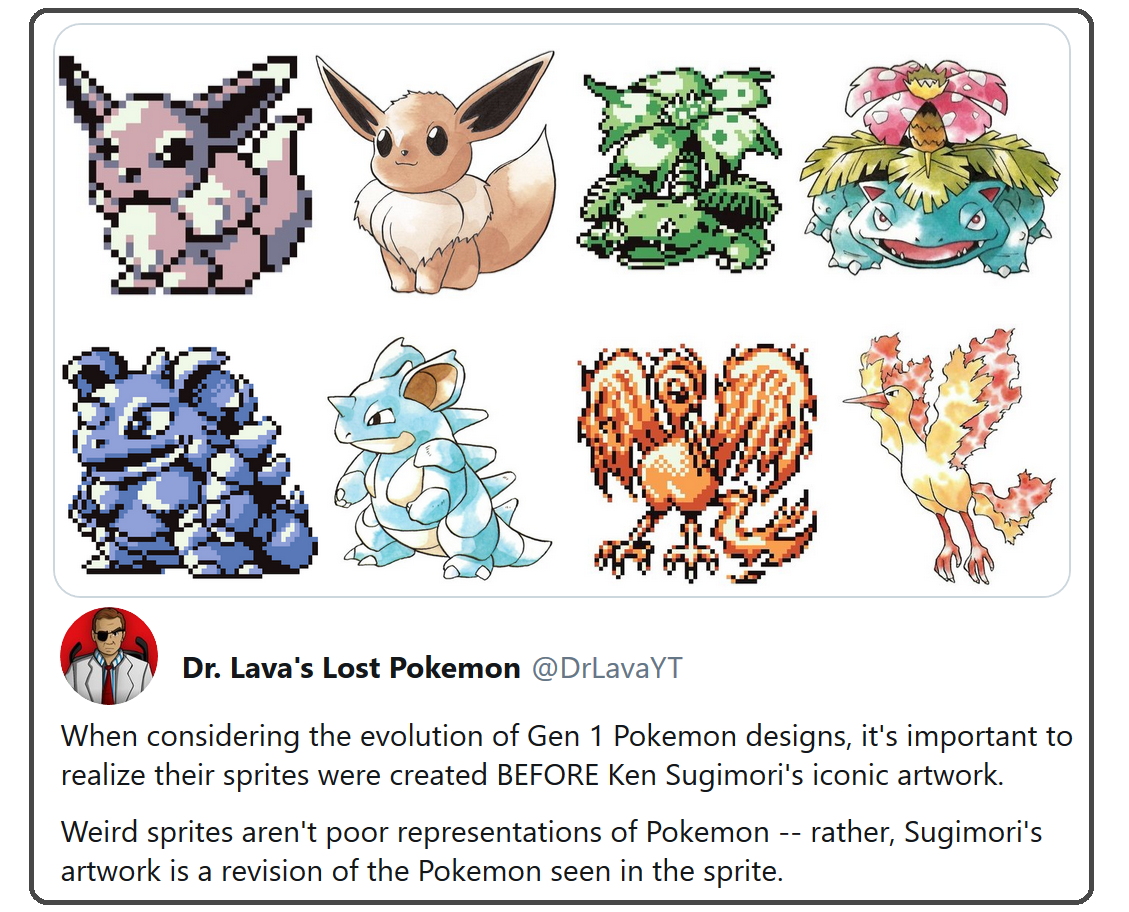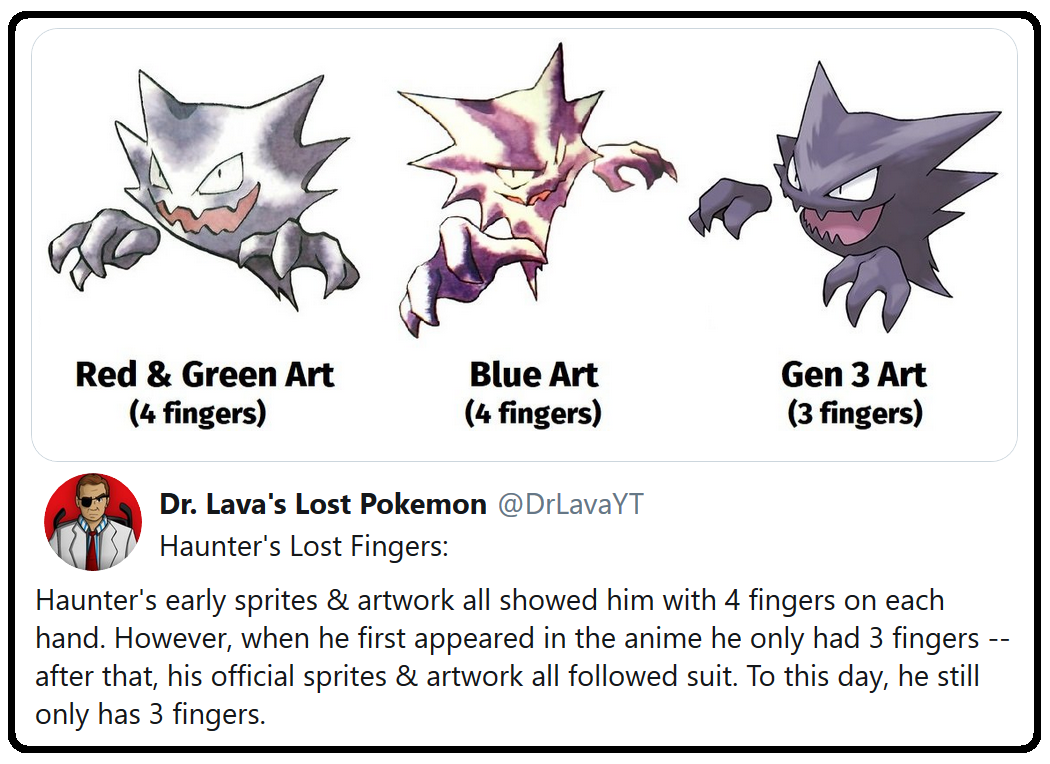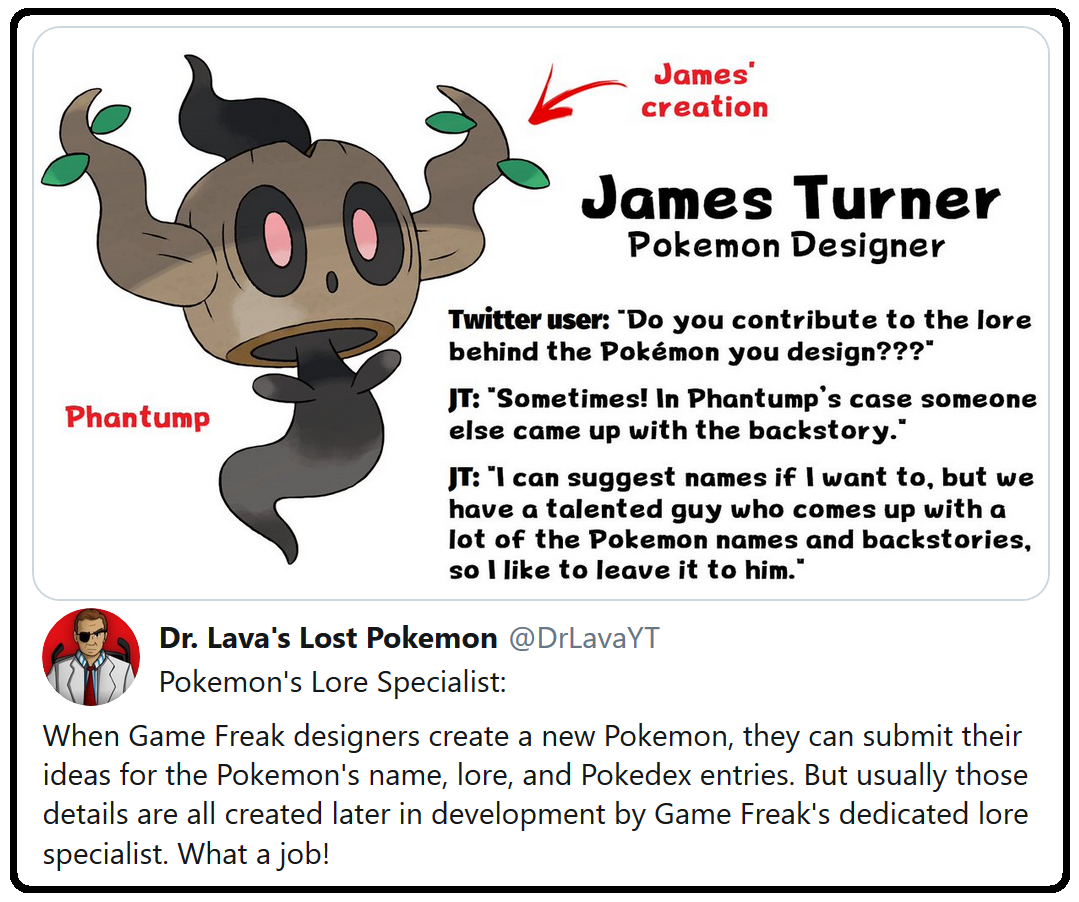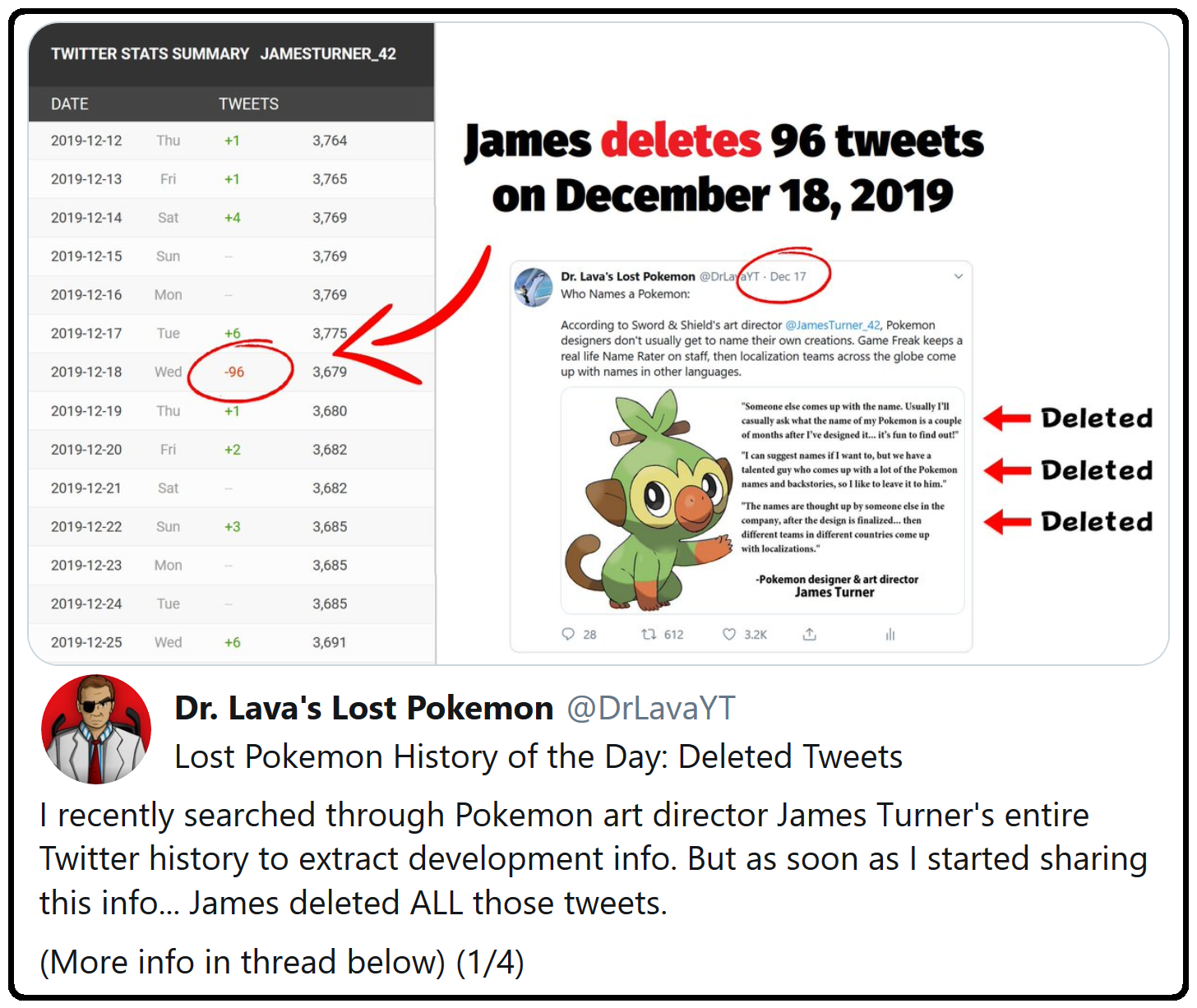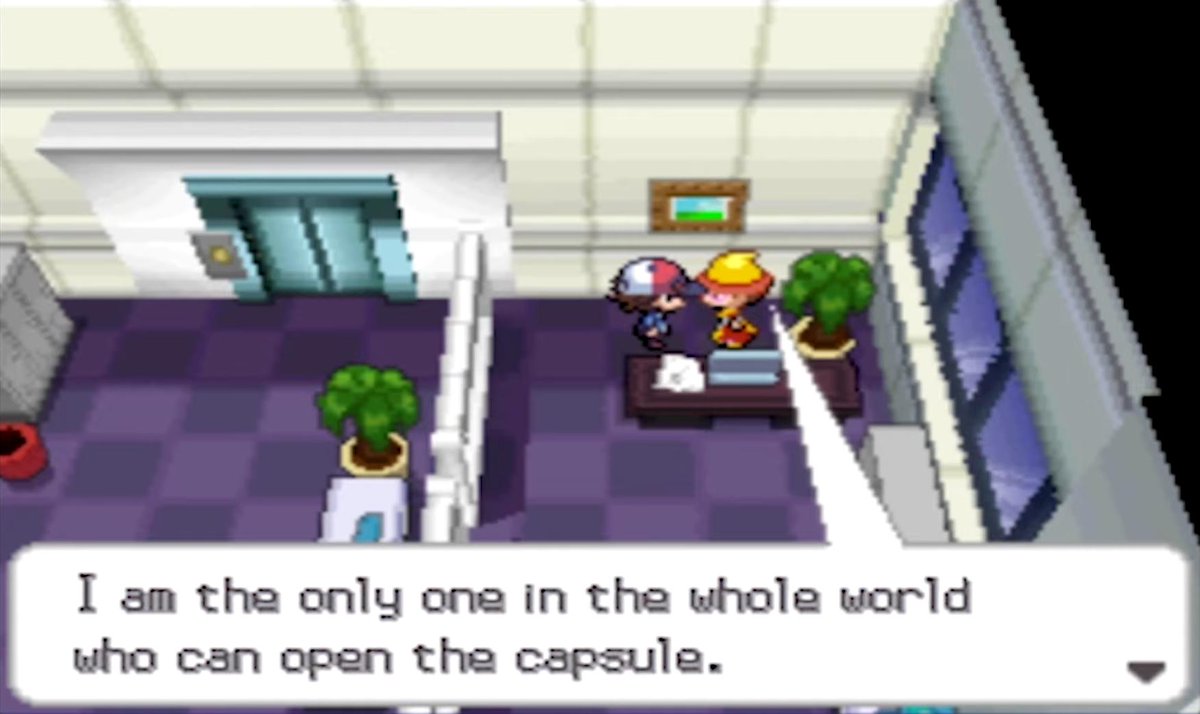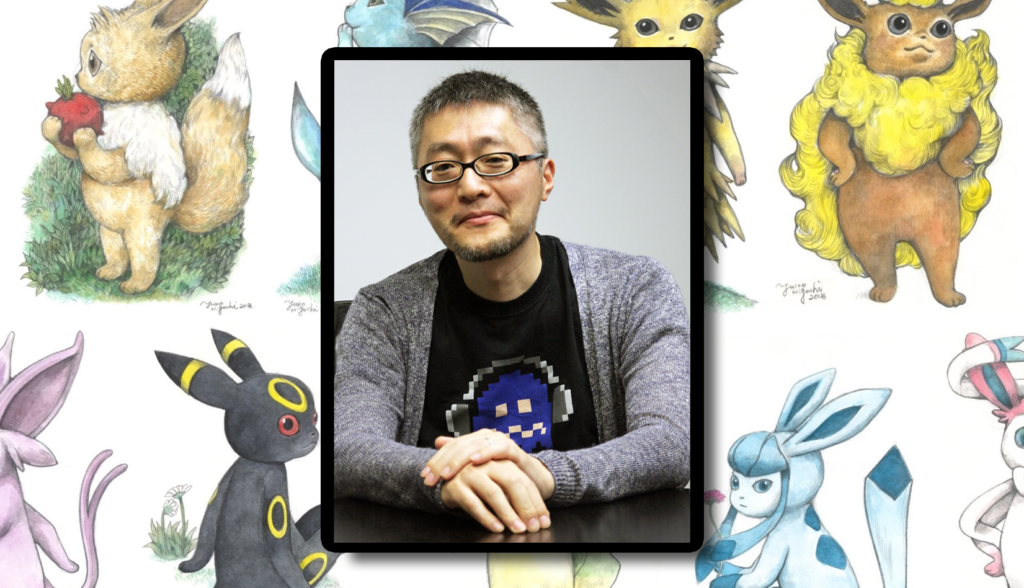
Translation: Eevee Family Origins & Development
By explaining Eevee, Game Freak explains ALL Pokemon

Written by Dr Lava • May 19, 2020
The interview translation you’re about to read explains how the Eevee family created, as revealed by Game Freak developers shortly before the release of Let’s Go Eevee. But even more importantly, this interview also provides new tons of new insight into how all Pokemon were created, especially the ones introduced in the first two generations. But before the translation begins, I need to provide some context for the events surrounding the interview.

In September 2018, The Pokemon Company hosted a week-long art exhibition in Tokyo called “EVs+cafe.” The exhibition showcased Eevee artwork from nine famous illustrators, including Yuko Higuchi, KUNIKA, and Ken Sugimori. Copies of all the artwork for sale, as well as exclusive Eevee-themed merchandise, desserts, and even a 95 page book featuring Eevee artwork, comic strips, and a six page interview with Eevee’s creators.

This Japanese-language book was never localized or sold internationally, so in this article I’ll be featuring scans from the book and photos from the exhibition. And I’ve also hired an interpreter to translate the book’s interview into English, which is what you’ll be reading below, along with some of my own commentary adding some relevant information. The three interviewees are Ken Sugimori, Atsuko Nishida, and Fujiwara Motofumi — here’s a brief introduction for each of them:
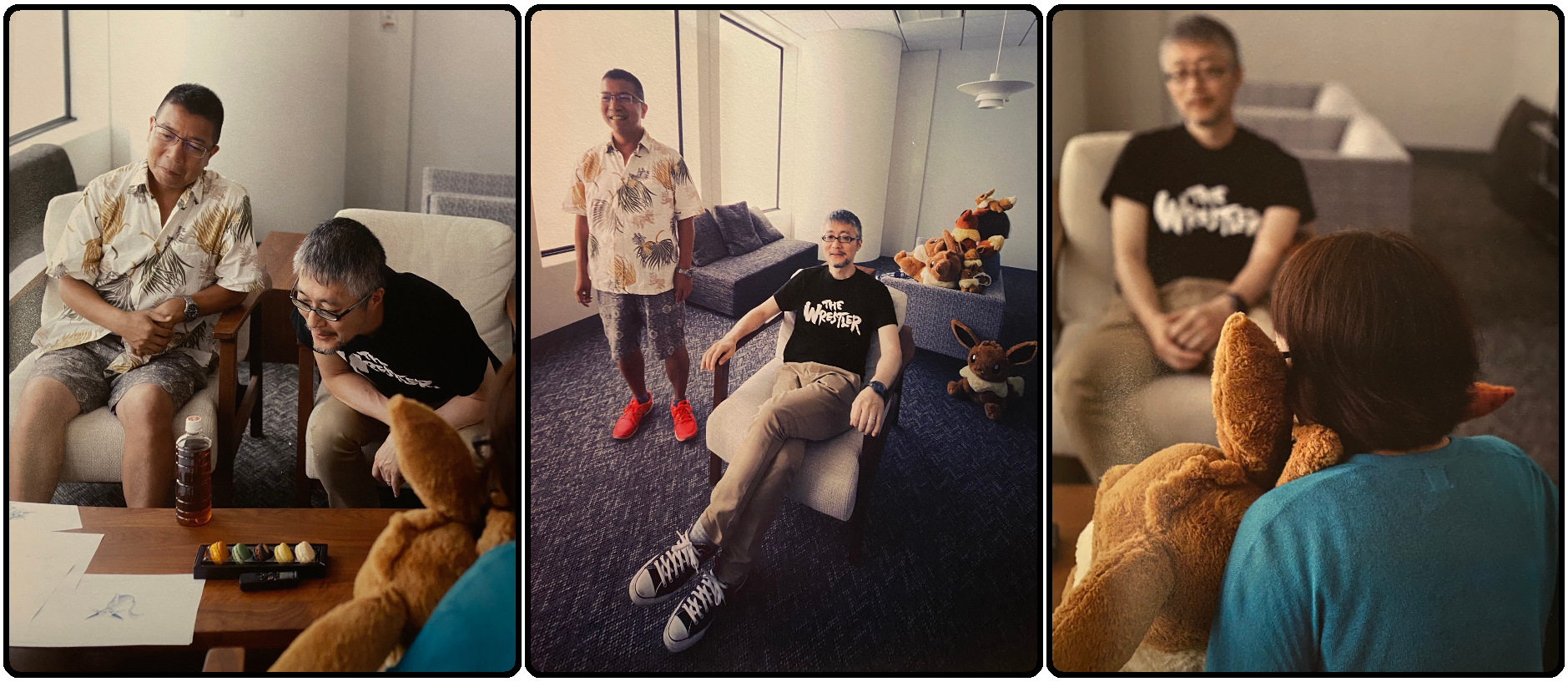
Ken Sugimori was the very first Pokemon designer and art director for Pokemon Red & Green, as well as many of the generations that followed. He didn’t create every Pokemon himself, but as art director, he finalized the designs for every single Pokemon. Remember when Pokemon artwork was in watercolor? Ken Sugimori made all of it.
Atsuko Nishida was Game Freak’s first female designer — she was brought on board for her ability to create cute Pokemon, a skill Sugimori lacks. Atsuko designed Pokemon for Generations 1-8, including many of the series’ most iconic monsters, like Pikachu, Bulbasaur, Charmander, and Squirtle. She’s notoriously camera shy — in the middle photo above, you can see she’s covered herself in a pile of Eevee plushies to avoid having her face photographed.
Motofumi Fujiwara was also one of Game Freak’s first designers, and just like Ms Nishida, is a very private person. He almost never grants interviews, and the only Pokemon we know he created were the ones specifically mentioned in this interview, despite the fact he’s been a Pokemon designer for nearly 30 years.
Before the interview begins, I’d like to thank Nicholas Quevedo for sending me photos of the exhibition, Anthony Madry for translating the interview, and my Patreon supporters who help fund all the Pokemon translations published on this website, including this one. Okay, now to the interview.
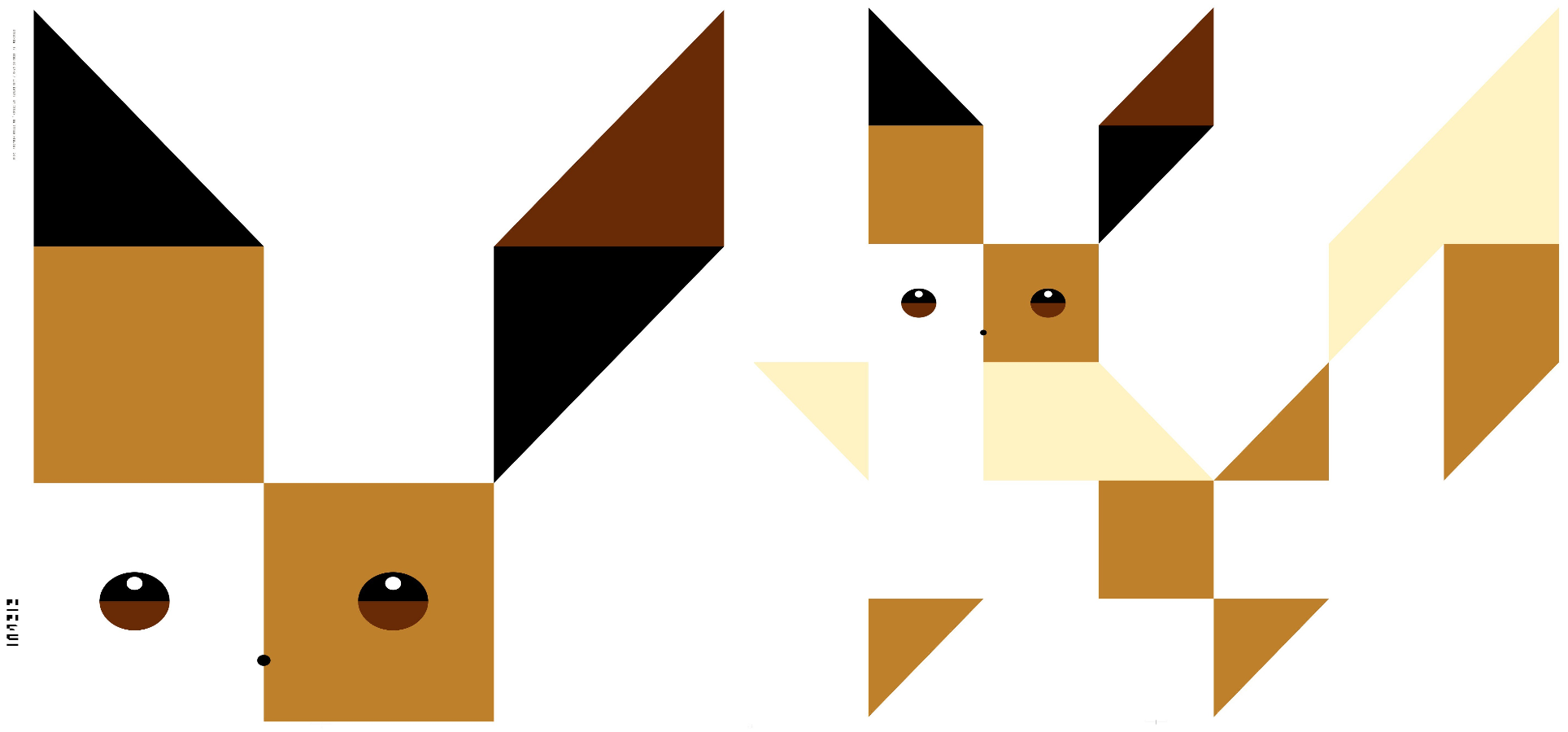
Interview: Creating Eevee
“It’s been 23 years since Eevee made its first appearance in Pokemon Red & Green. So we’ve gathered all three designers who were involved in Eevee’s creation, as well as the evolutions that followed, for an interview to hear their thoughts about Eevee, and some untold stories about Eevee’s origins!”
“Being able to meet all three of you at the same time is increasingly rare, so I’m pretty nervous, but I’m looking forward to this interview. First off, Eevee’s original designer was Mr Fujiwara, isn’t that right?”
Fujiwara: “That’s right.”
“Was the idea of having multiple evolutions already established before you started working on Eevee’s design?”
Fujiwara: “Yes, I was asked to design a Pokemon that evolves into multiple types.”
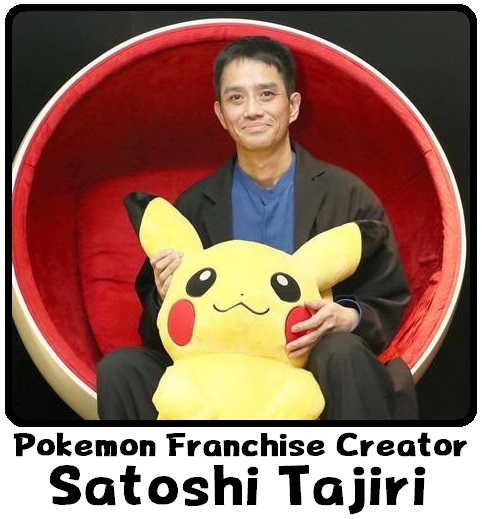
“You were asked by Mr Satoshi Tajiri?”
Fujiwara: “Yes.”
“So after you got the request, how did you decide what Eevee would look like?”
Fujiwara: “Since Eevee has very different evolutions, we thought it might be a good idea to make Eevee a Pokemon without a type, as well as a Pokemon that can’t be identified as any specific animal based on its appearance. We decided it was best to create a ‘blank slate’ Pokemon.”
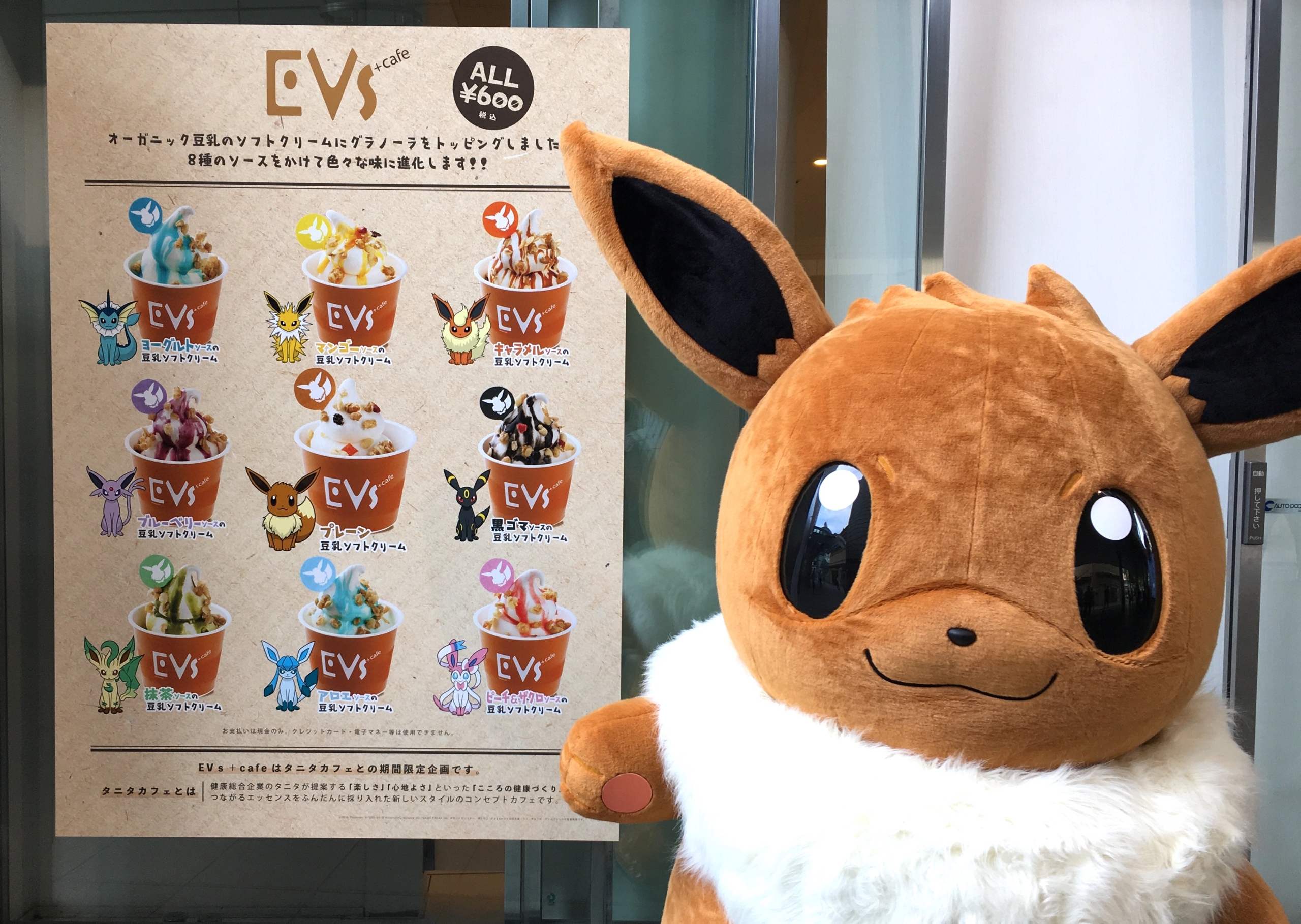
“So you were aiming for something as plain as possible?”
Fujiwara: “That’s right.”
“So from the initial stages of its conception, were you imagining a Pokemon similar to the Eevee we have now, with long ears and fur around its neck?”
Fujiwara: “It had ears, a fluffy tail, and white fur around its neck. We imagined something that’s not a fox, a dog, or even a cat. Something cute with four legs, but not really anything in particular.”
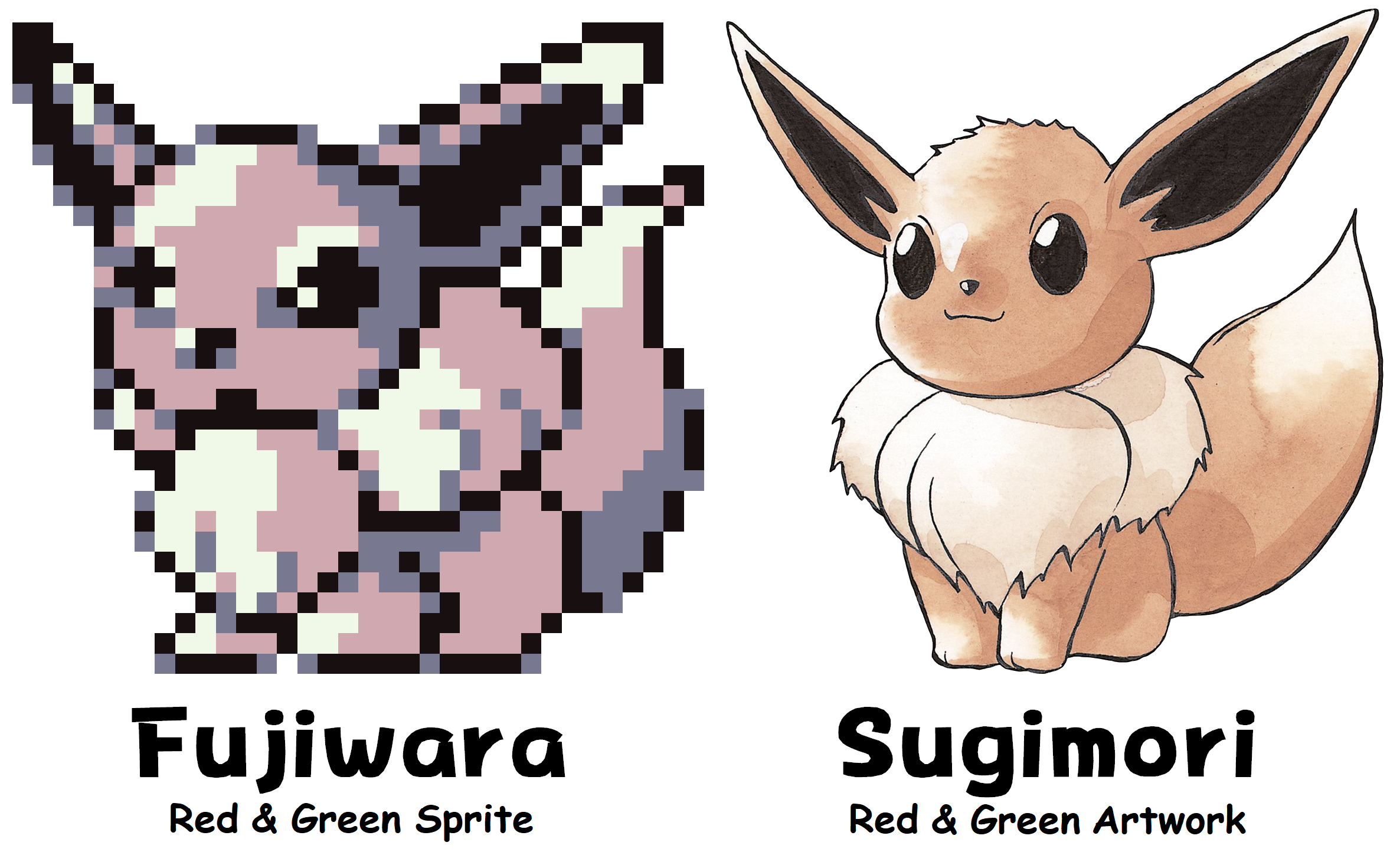
“So from the very beginning, Eevee was always Eevee? It always had four legs and looked like Eevee?”
Fujiwara: “Yes.”
“Mr Sugimori, what did you think the first time you saw Eevee’s sprite?”
Sugimori: “When we were developing Red & Green, the designers were programming sprites into the game without me checking them first. I never even saw Eevee until it was already in the game!” (laughs)
(laughs) “So at that time you didn’t make artwork then convert it to sprites — instead the sprites were made first, then you made the artwork later?”
Sugimori: “That’s right.”
Dr Lava’s notes: When Game Freak’s design team created Pokemon for Red & Green, they made the sprites first, often without so much as a pencil sketch to use for reference. This is called pixel art. After all 151 Pokemon were programmed into the games, Ken Sugimori made the official artwork for each Pokemon based on their sprites. Some designs he left mostly unaltered, but others he changed pretty substantially, like Nidoqueen and Venusaur. When Sugimori finalized Eevee’s design, he made it less aggressive and more cute. It’s particularly interesting to hear the developers say that Eevee — and presumably lots of other Gen 1 Pokemon — were programmed into Red & Green without Sugimori’s authorization or approval. He never even saw Fujiwara’s Eevee sprite until it was already programmed into the game.
“So it sounds like Eevee’s original design was Mr Fujiwara’s idea. The Eevee sprite in Red & Green had a bit more of an aggressive feel to it compared to the Eevee we know today.”
Fujiwara: “That Eevee sprite looks the way it does because it was created in a battle sequence.”
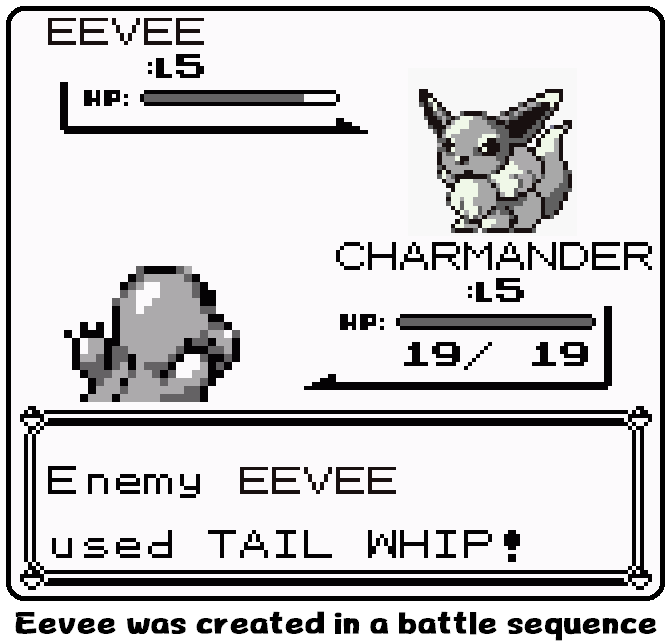
“I see! Eevee was created as a small Pokemon, but after it evolves, it grows as large as one meter. Was that one of your ideas Mr Fujiwara?”
Fujiwara: “No, that’s not what I was thinking at all!” (laughs)
Sugimori: “Of course, in those days we were designing Pokemon for the first time. There were some Pokemon we created without even considering what size they were. Later, when those Pokemon would appear in the anime, there were times when we thought “Wow, that’s bigger than I was imagining!” There was some difference between what we’d created and what ended up coming to fruition. So we gradually made adjustments.”
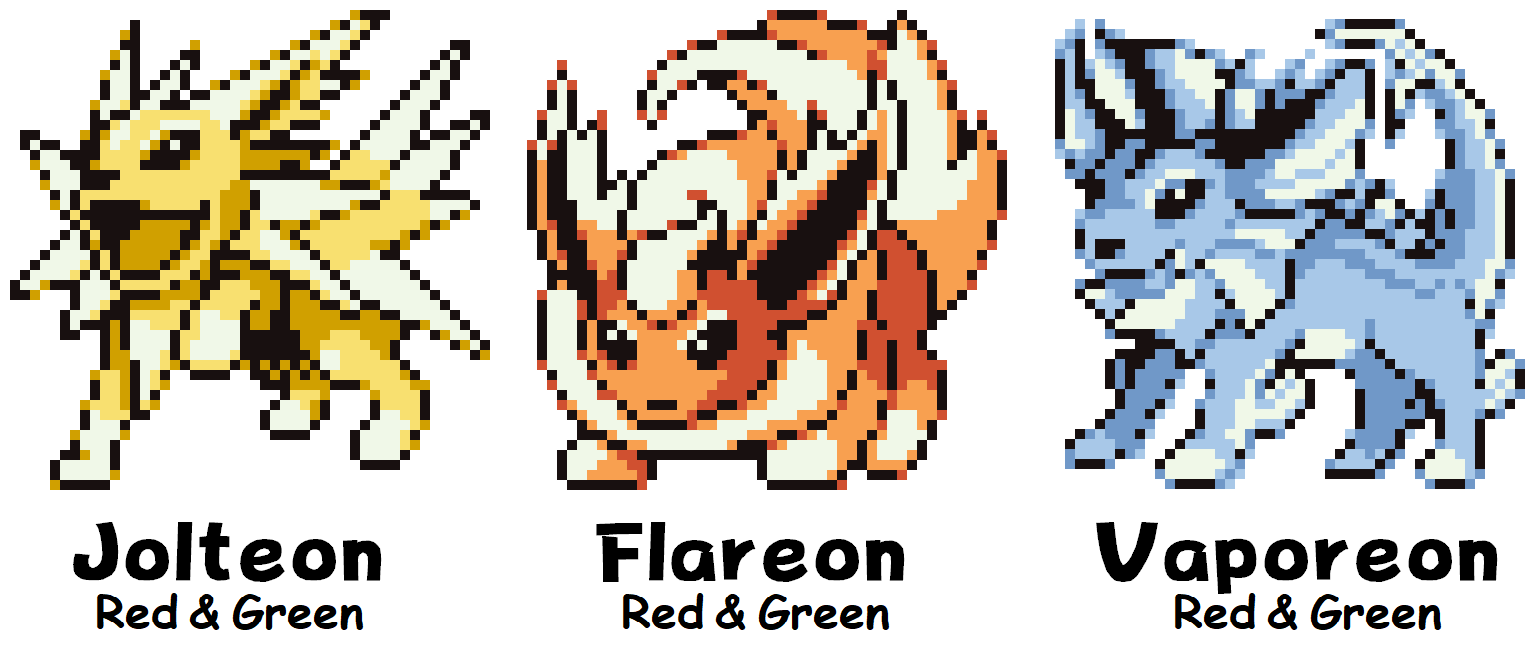
“By the way, when Mr Fujiwara received the request to make Eevee, were the evolutions’ Fire, Water, and Electric types already decided?”
Sugimori: “We made Eevee first, then came up with the types later, if I remember correctly.”
Nishida: “Were the types already decided? I can’t remember.”
Fujiwara: “I don’t believe that’s how it happened… or was it? It happened so long, ago I can’t really remember.” (laughs)
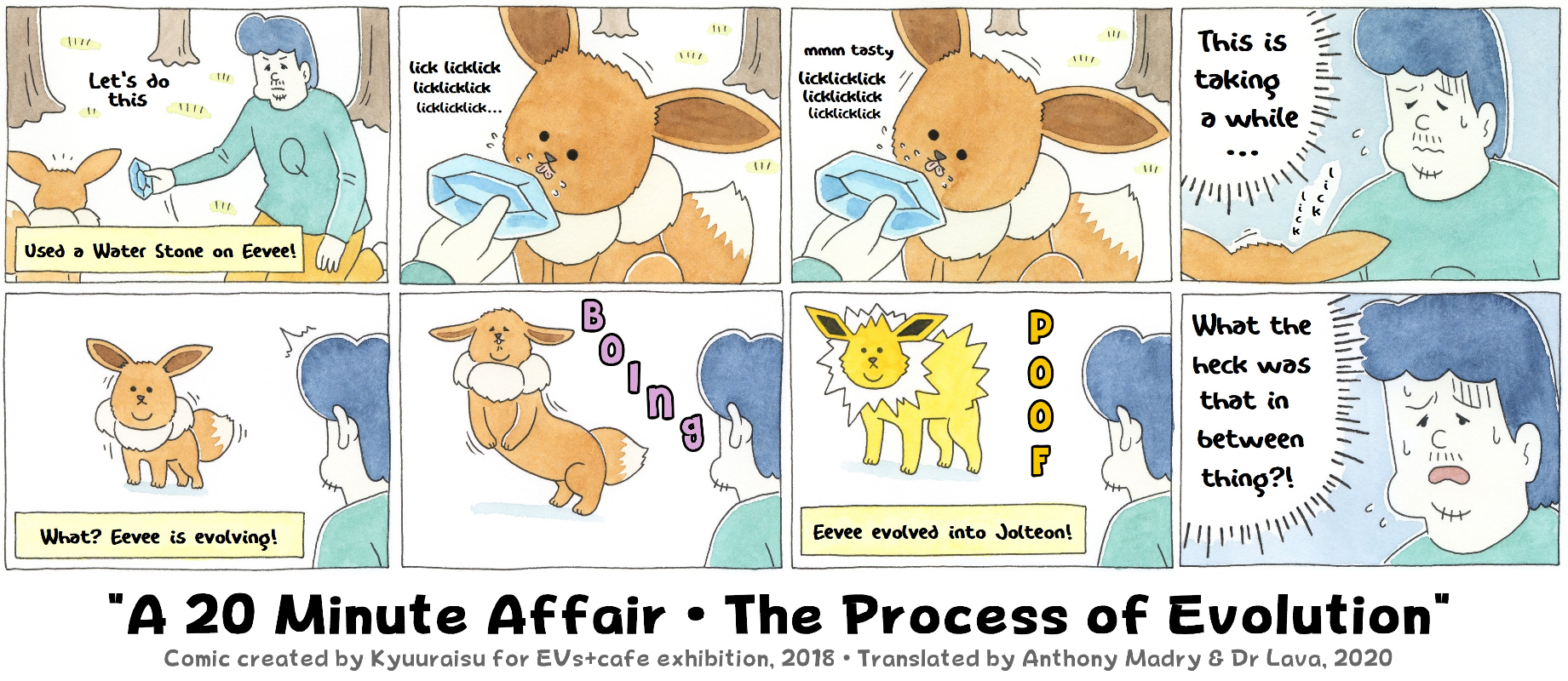
(Laughs) “Was the idea to make Eevee evolve with evolution stones decided during the Pokemon design process? Or rather, did the idea for evolution stones come about while you working on the gameplay?”
Sugimori: “I’d say it was for the gameplay, rather than for the Pokemon design. It allowed players to choose which direction they wanted Eevee to branch off in evolution.”
“Players being able to choose Eevee’s evolution became its defining feature. As for the Eeveelutions, weren’t you in charge Ms Nishida?”
Nishida: “Mr Fujiwara created Jolteon and Flareon, then later on I created Vaporeon.”
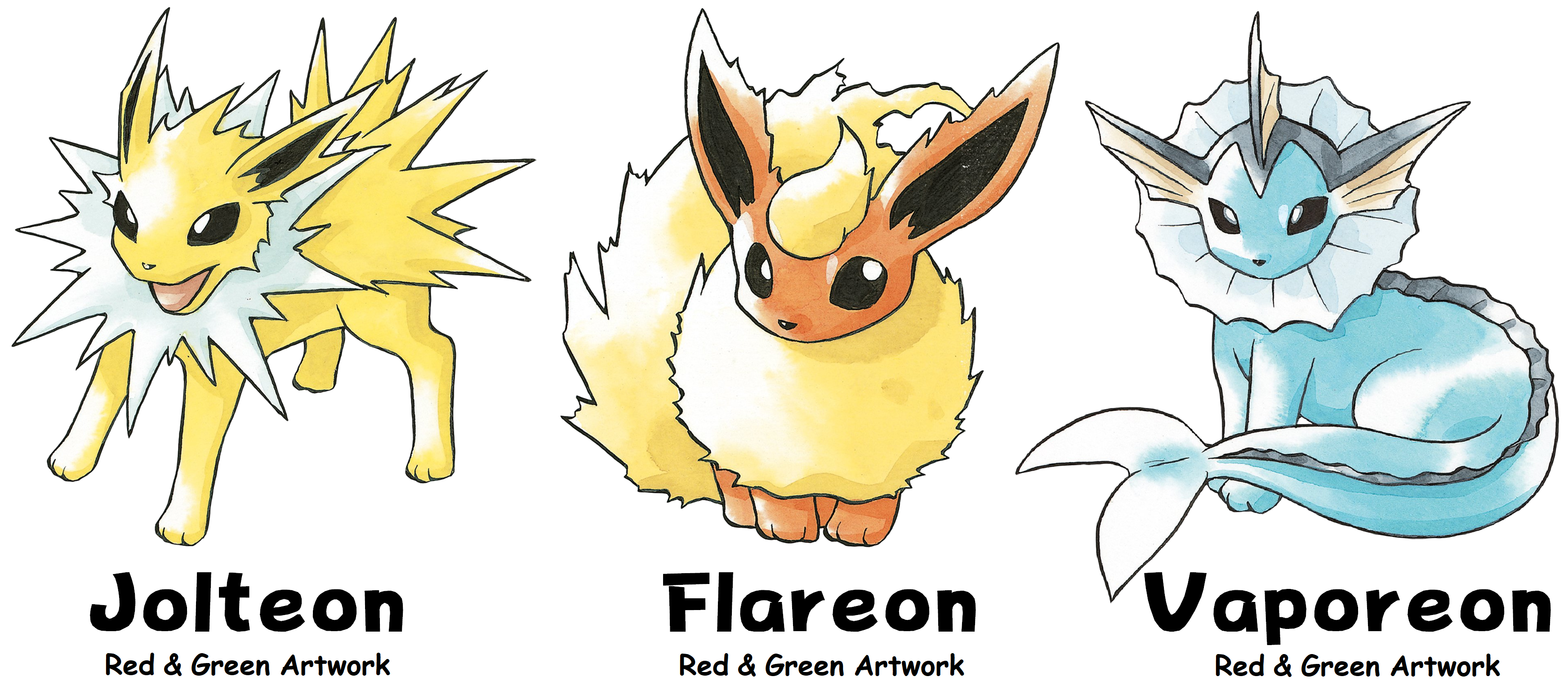
Sugimori: “At the time Ms Nishida was in charge of Vaporeon, and now she’s been in charge of every Eeveelution since Gold & Silver.”
“Designing Vaporeon based off Mr Fujiwara’s Eevee design, I imagine it must have been difficult not starting from your own ideas as a base. How did you approach the situation?”
Nishida: “Mr Fujiwara’s concepts for the Fire and Electric types in Flareon and Jolteon were very easy to understand, so with that in mind, it was pretty easy to imagine what a Water evolution might look like. I think Vaporeon ended up looking the way it did precisely because I used Mr Fujiwara’s designs as a starting point.”
“You can tell that when it comes to the Eeveelutions, Vaporeon has a lot of fans. For example, KUNIKA, who’s one of the nine artists participating in this Eevee exhibition, says she loves Vaporeon because of its elegance.”
Nishida: “Is that right??”
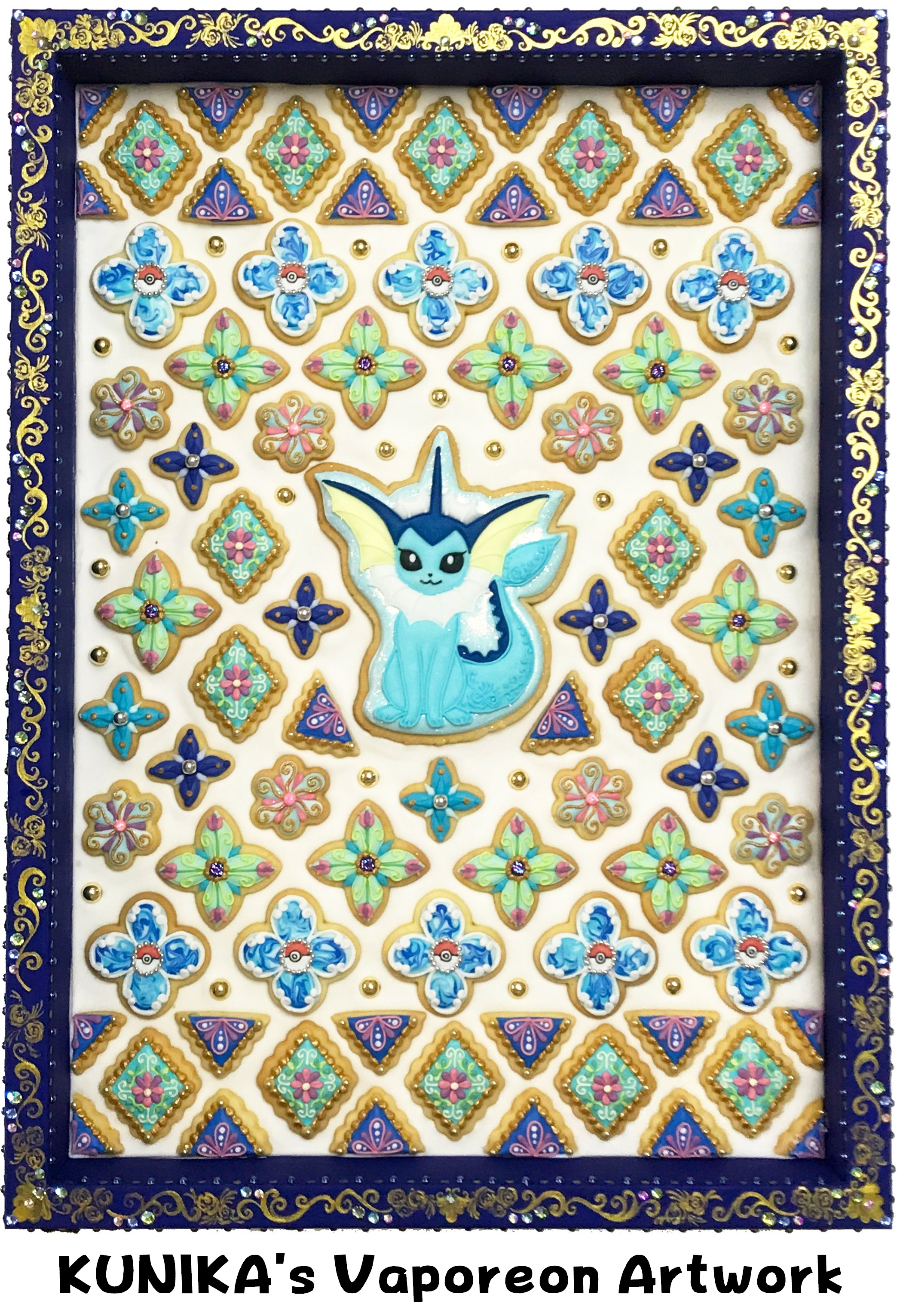
“Considering its unique tail and neck fin, it makes sense that Vaporeon is so popular. It’s also kind of cute and rough at the same time, that’s a bit different.”
Sugimori: “I actually thought it was kind of a weird mermaid design. (laughs) Was it designed with elegance in mind?”
Nishida: “Elegant… well not particularly.” (laughs)
(Everyone laughs)
Nishida: “I had the image of a mermaid in mind, so I made Vaporeon’s tail very mermaid-like, and that’s basically how I came up with the concept of a Water Eevee. That’s probably why it has so much of a mermaid feel to it.”
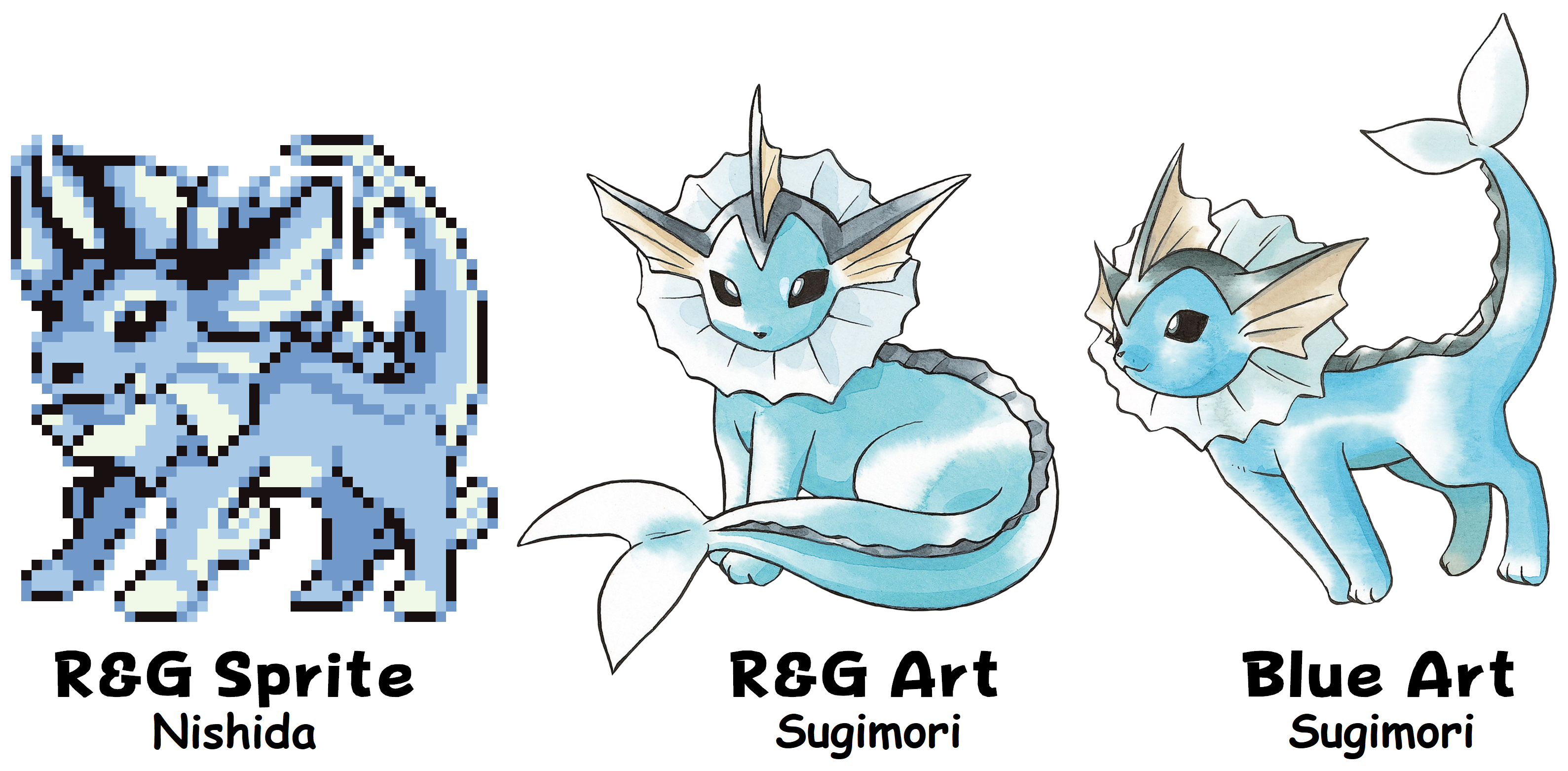
Dr Lava’s notes: It’s worth pointing out that of all the Eeveelutions, Vaporeon was the design Sugimori changed the most when he converted Red & Green’s sprites into artwork. Atsuko Nishida originally made Vaporeon more dog-like and gave it fins on each leg, but Sugimori revised Vaporeon to make it more cat-like and removed the fins. As you can see from this side-by-side comparison, he also made a few more small revisions.
The evolution of Eevee and the evolution of the games
“In Gold & Silver, we got the addition of Espeon and Umbreon, and although they still resemble Eevee, they have a very different coolness and cuteness to them compared to the first three Eeveelutions. They have a very slender feel to them. Ms Nishida, what was your focus when you designed them?”
Nishida: “I have to say, it was their types. Psychic has a very mysterious vibe to it, so I wanted to bring that out in the design.”
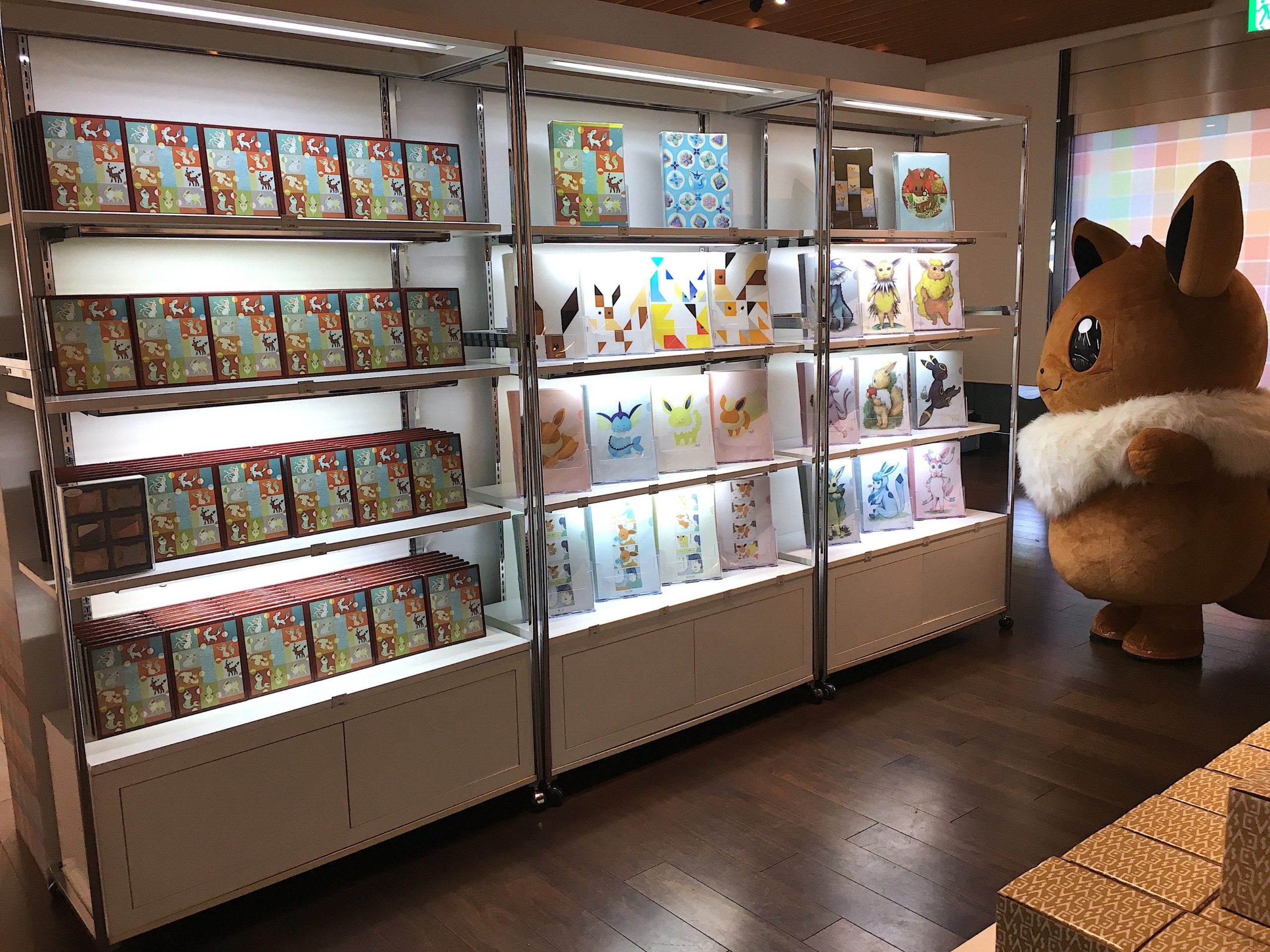
“Since Gold & Silver were developed for the Game Boy Color, I guess you had to think about how the colors would look on the GBC screen. For example, making Umbreon black and yellow.”
Nishida: “When Gold & Silver were in development, we were still designing Pokemon with monochrome sprites. So I was only imagining them in black and white.”
“So while you were making Gold & Silver you still weren’t designing with color?”
Nishida: “That’s right. I was still designing in monochrome. It was Sugimori who did all the detailed coloring.”
Sugimori: “Yeah, the coloring was probably me.”
Nishida: “When I designed Umbreon, I wasn’t really thinking about the color of its ring pattern.”
Sugimori: “Well in those days things were done pretty quickly, and you had to add every pixel individually, and also revise the sprites manually.”
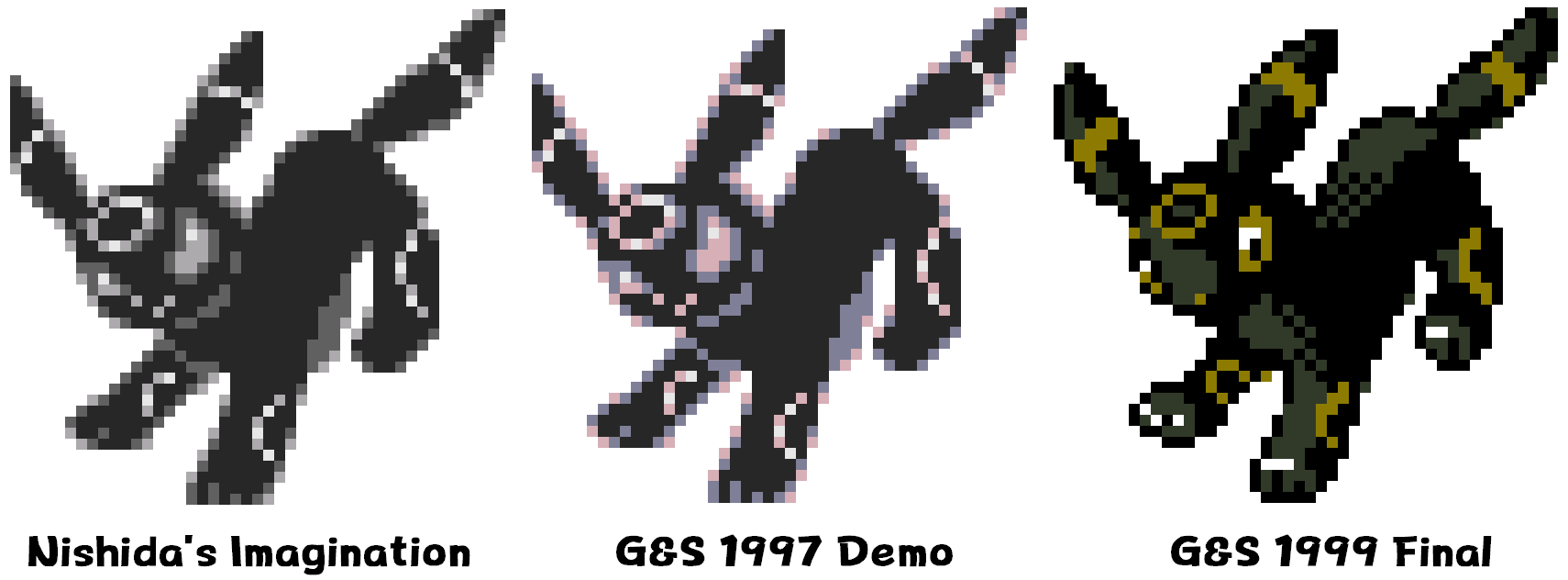
Dr Lava’s notes: Game Freak was developing Gold & Silver for the Game Boy Color, but they were still designing Pokemon sprites in black and white. Interesting! It’s worth pointing out that in Gold & Silver’s 1997 demo, Umbreon’s sprite looked nearly identical to the sprite that appeared in 1999’s final build. The most striking difference of course, is the demo sprite’s purple color was changed to gold.

Likewise, Espeon’s design was also very similar in Gold & Silver’s 1997 demo, with the main difference being its change from yellow to purple. The color swap was probably due to the fact Jolteon was yellow, and they didn’t want Espeon and Jolteon to look too much alike. Based on what they’re saying in this interview, these color swaps were Sugimori’s decision, not Atsuko Nishida’s. It sounds like it was Sugimori who decided every Pokemon’s colors, at least in Gen 2.
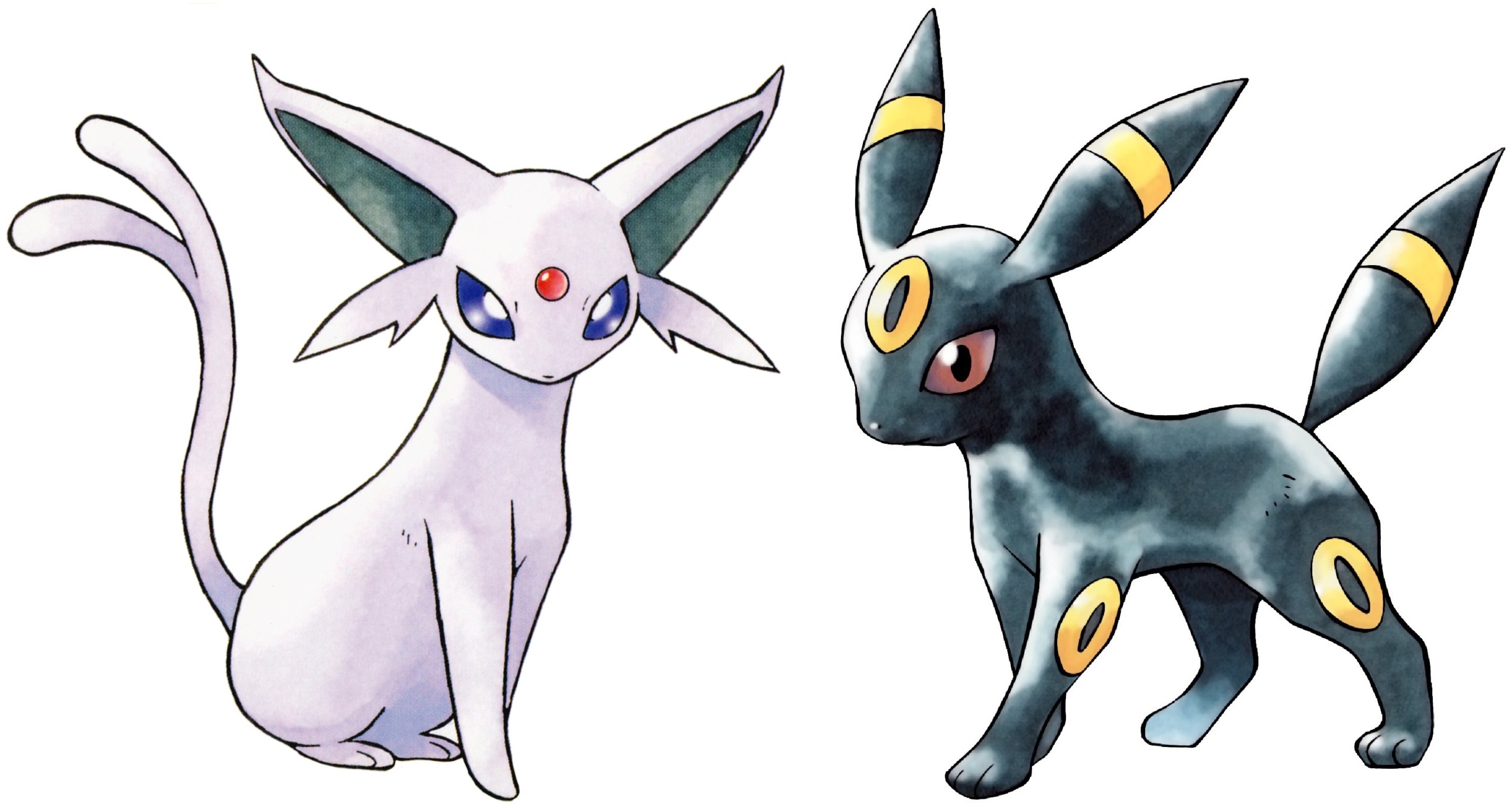
The developers don’t clarify who revised the sprites between 1997’s demo and 1999 release version, but it’s probably safe to assume it was a team effort, with Game Freak’s whole design team pitching in. Then later on of course, Sugimori ultimately finalized all Gen 2’s Pokemon designs with his watercolor artwork, just like he did in Gen 1.
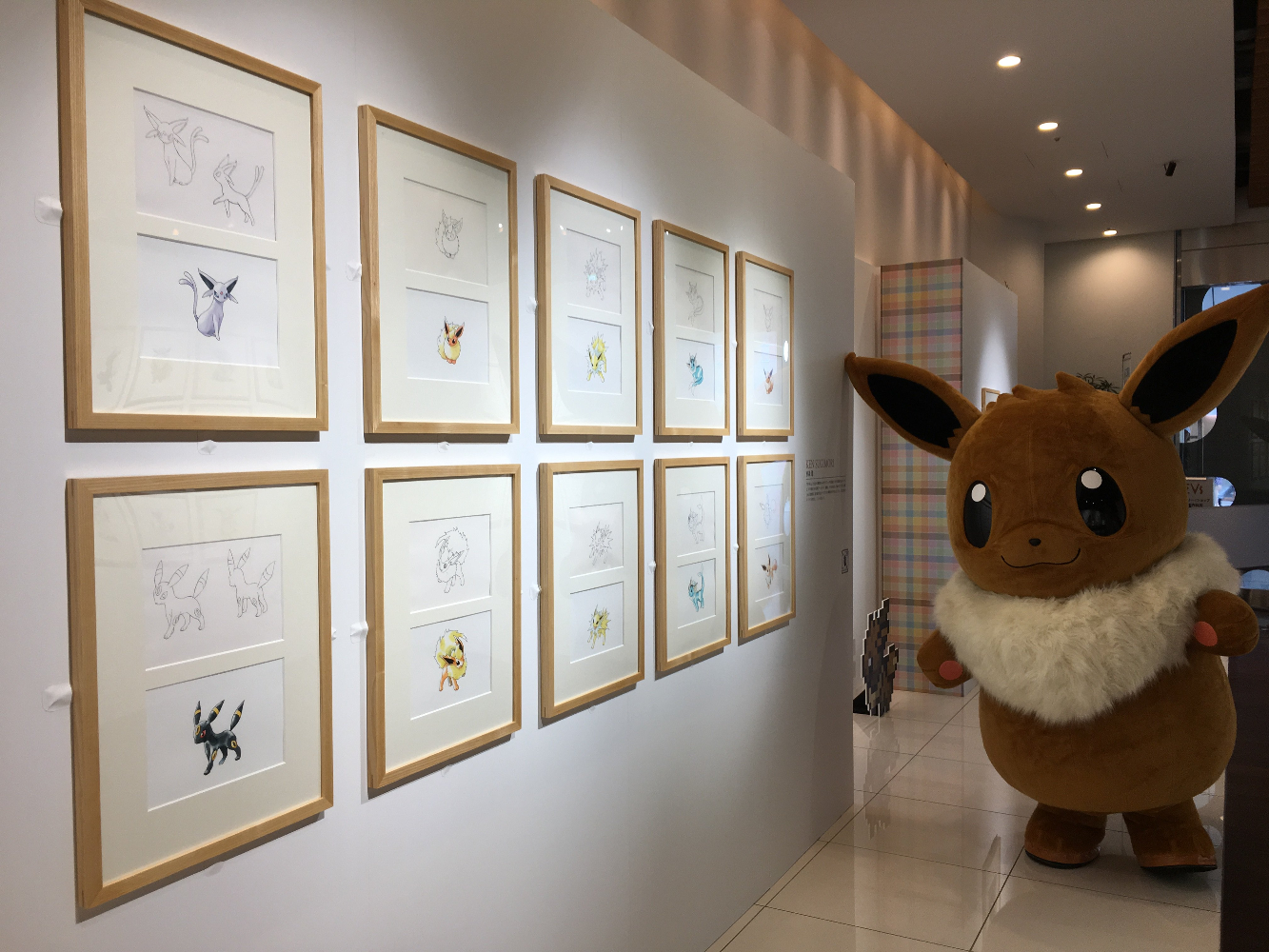
Speaking of Ken Sugimori, the EVs exhibition actually featured all Sugimori’s Eevee artwork — the original sketches and watercolor he made back in the 90’s. The collection included all ten pieces from the Red & Green, Blue, and Gold & Silver sets. Interestingly, Espeon and Umbreon had additional sketches from alternate perspectives — they were likely never colorized.
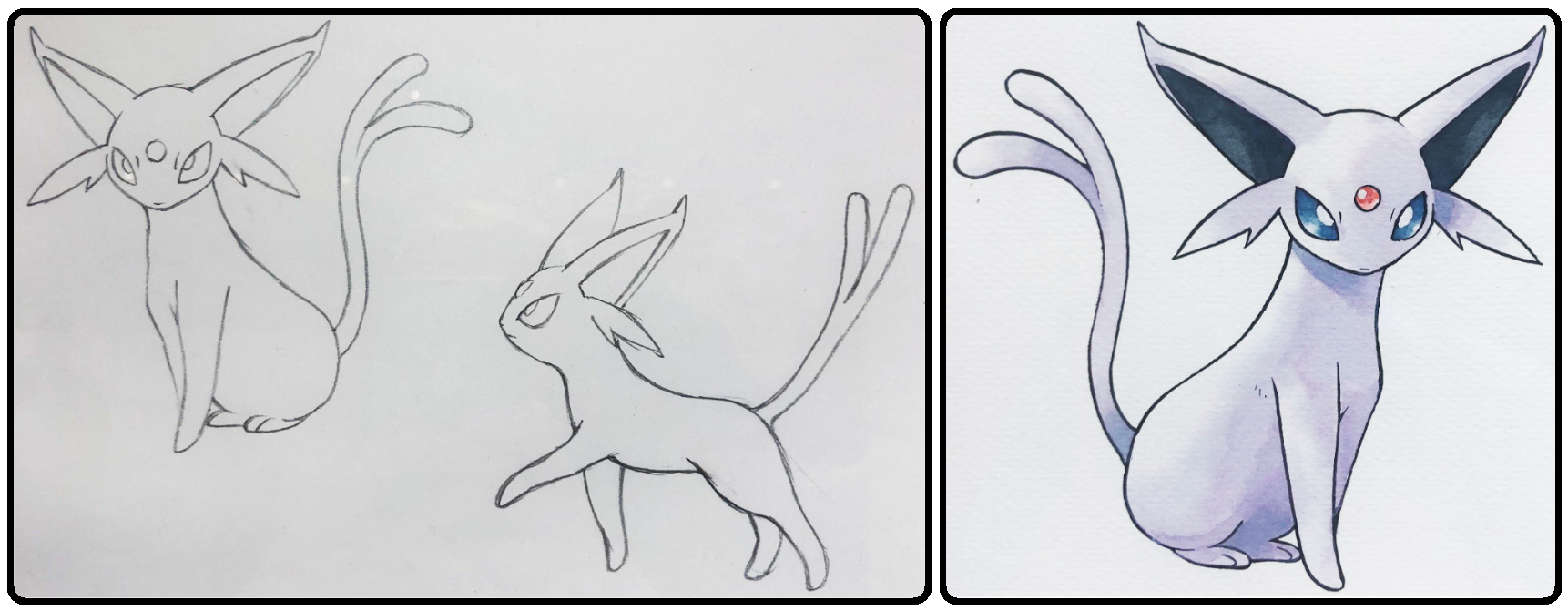
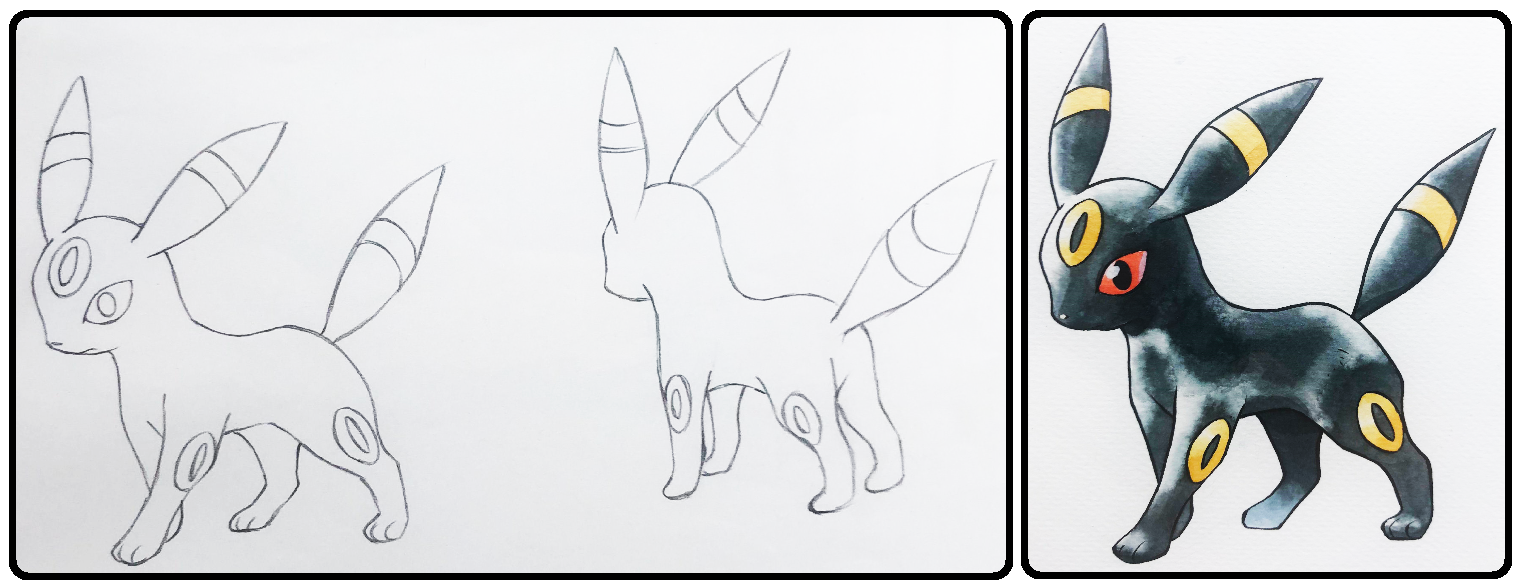
These original pieces were all under glass of course. It’s comforting to know the Pokemon Company has been preserving and protecting historically significant artwork for the past 20+ years. If they still have all these originals for the Eevee family, it stands to reason they’ve likely got the original artwork for every Pokemon ever made — and probably all the series’ Lost Pokemon as well… all locked away in a vault somewhere, waiting for the day they decide it’s convenient to reveal some, bit by bit.
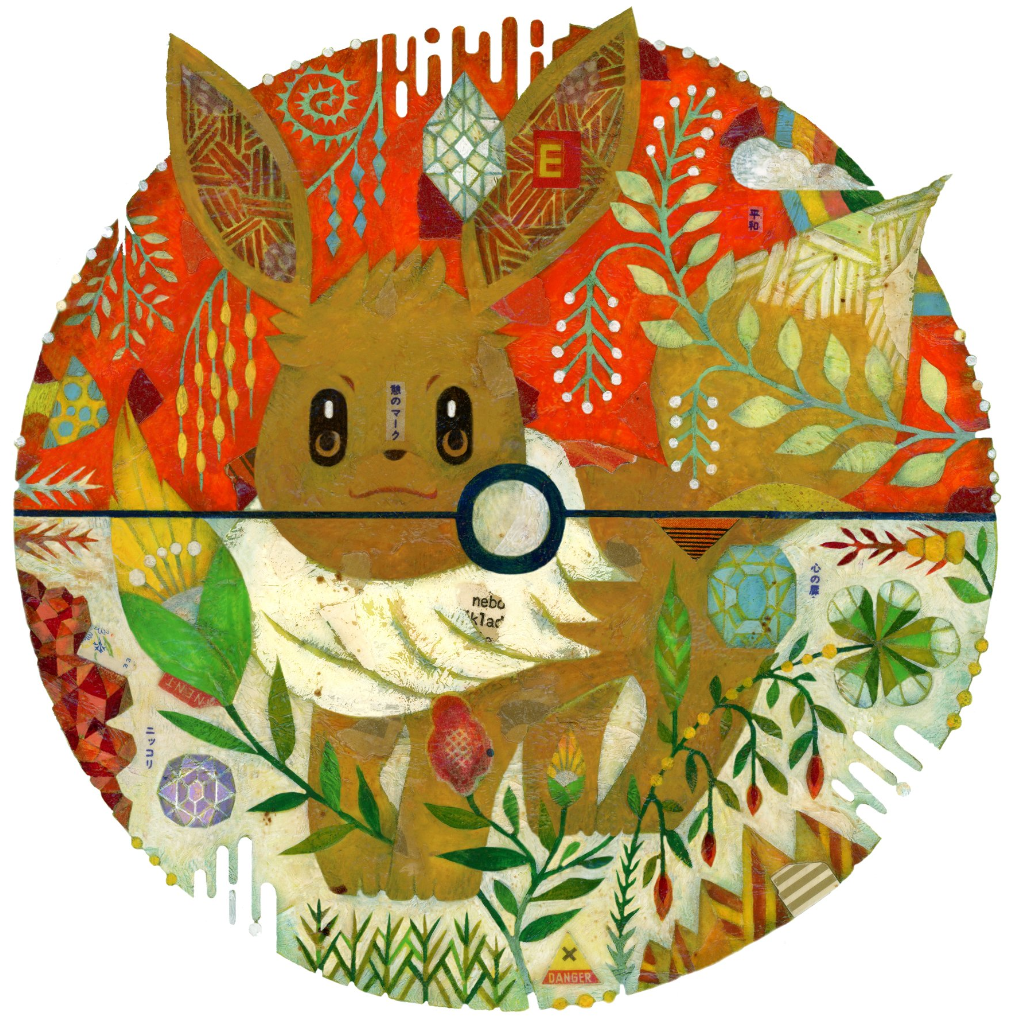
“Many people, including some of this exhibition’s participants, have their own theories and opinions about what kind of fur or skin texture the Eevees have. As far as their texture, what did you have in mind when you created these Pokemon?”
Nishida: “I don’t think that’s something we thought about when we were designing them. We didn’t design them and think ‘Oh, it’d probably feel like this.'” (laughs)
(Everyone laughs)
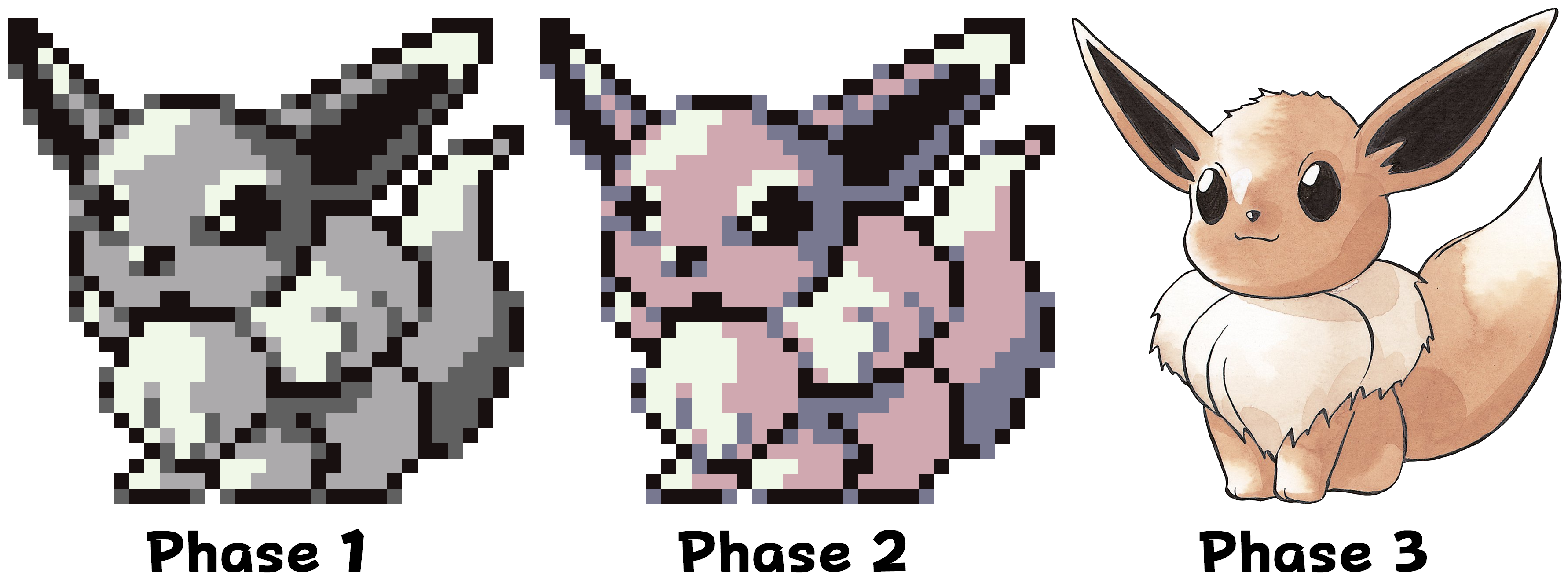
“You also have to figure out how to express that with the limitations of the pixel art at the time (laughs). Starting with Gold & Silver, Pokemon games finally became colorized. That means your team had to think about how to colorize each Pokemon, including Eevee. I assume this was done by referencing Mr Sugimori’s artwork.”
Sugimori: “When we heard about the Super Game Boy, we decided to give each Pokemon one color. This color usually corresponded to their type, but since Eevee’s defining characteristic is it’s lack of a type, we used the most natural color.”
“As Mr Fujiwara stated earlier, Eevee’s a ‘blank slate’ Pokemon.”
Sugimori: “To keep Eevee from looking like a specific type, we just made it the color of natural animal fur.”
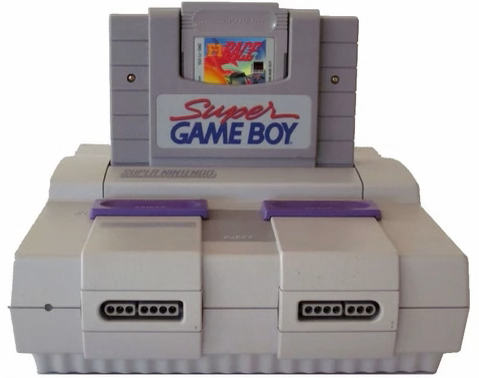
Dr Lava’s notes: The Super Game Boy launched in June 1994, relatively late in Pokemon Red & Green’s six year development (1990-1996). By plugging a Game Boy cartridge into the SGB, then inserting the SGB into a Super Nintendo, gamers could play Game Boy games in color on their televisions. As Game Boy games, Pokemon Red & Green were initially developed in black & white, but the launch of the Super Game Boy suddenly allowed Game Freak to add color.
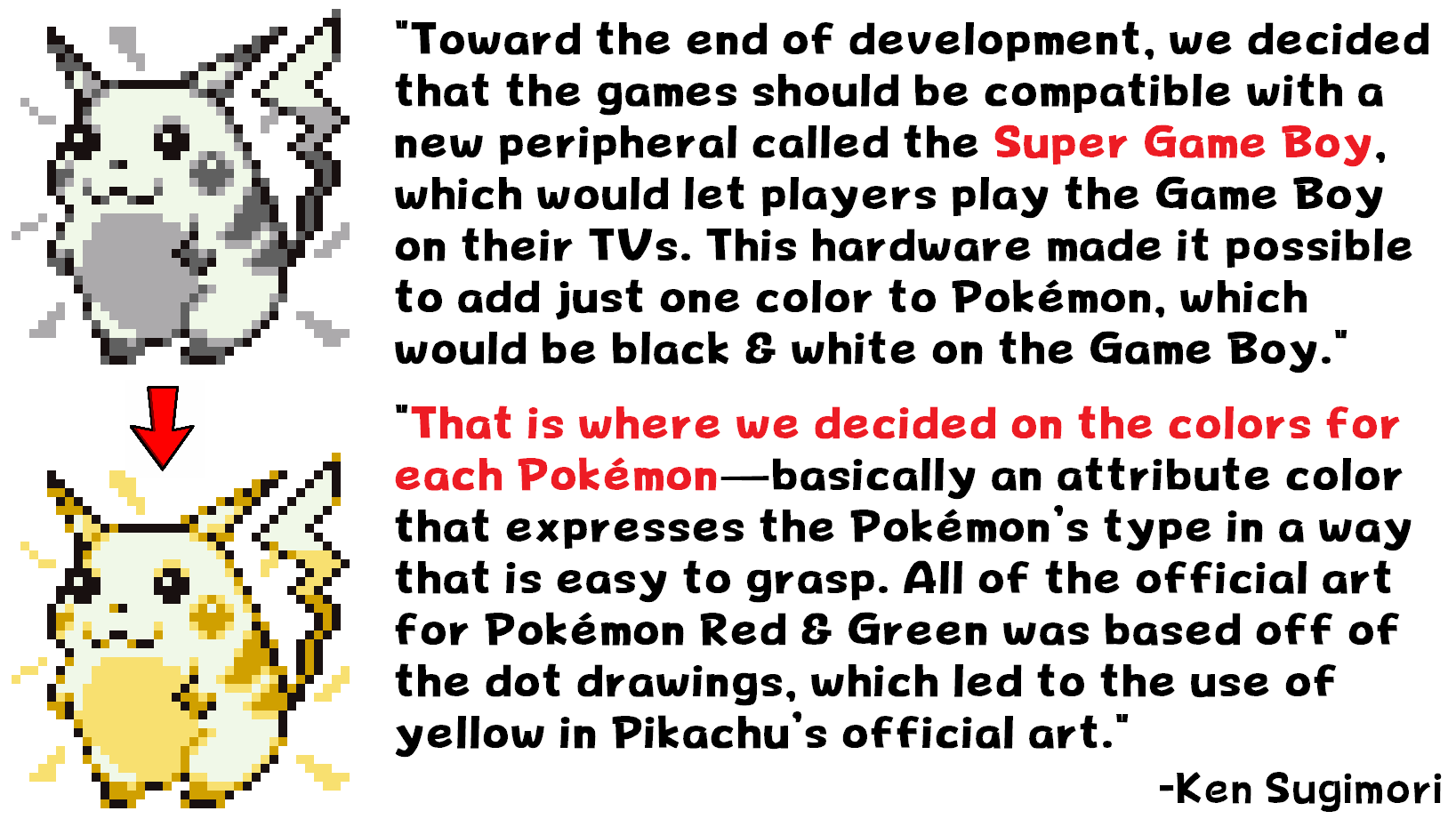
In a May 2018 interview with Japanese newspaper Yomiuri, Ken Sugimori explained his team mostly gave each Pokemon a color palette that “expresses the Pokemon’s type.” So Pikachu became yellow, Squirtle became blue, etc. It seems most Pokemon didn’t have colors before this point in development, not even in Game Freak’s imaginations.
“That’s something I noticed. Of course as gaming hardware progressed, the resolution of the Pokemon sprites progressed as well. But we see that even comparing Red & Green to Blue, which are all on the same console, Eevee’s appearance changed.”
Sugimori: “Yeah, it got cuter and cuter.”
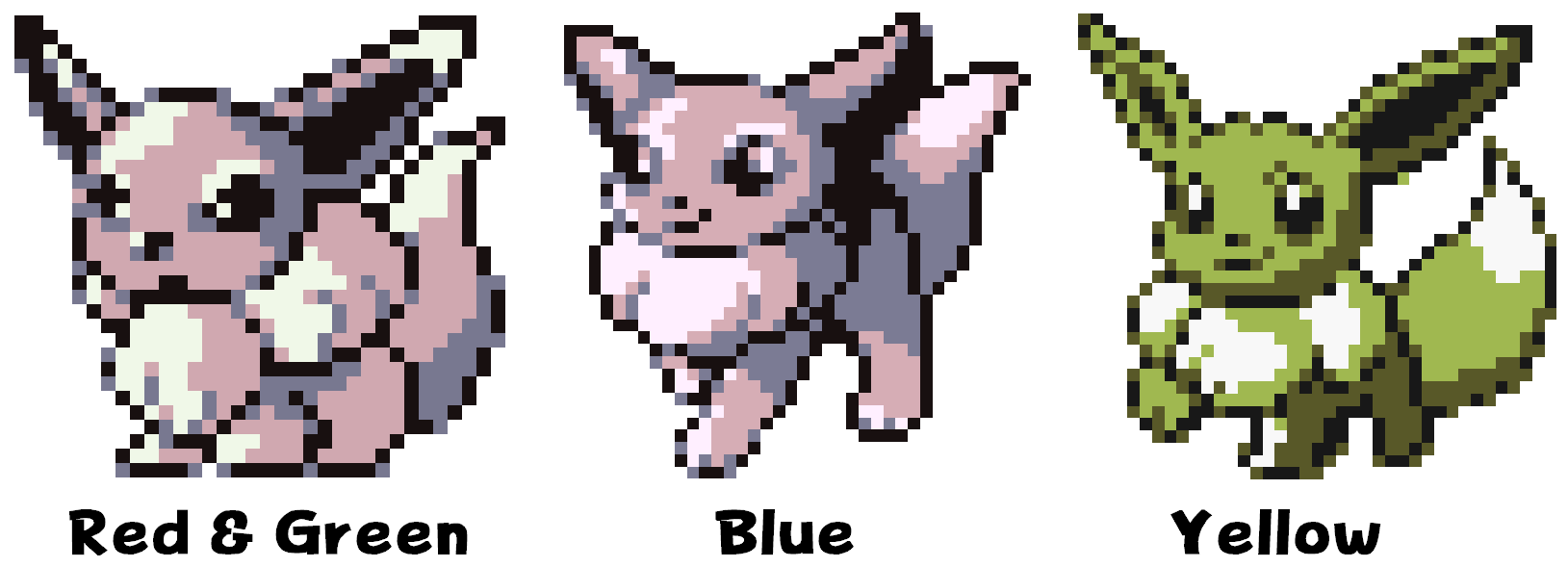
“So even though the limitations of the Game Boy and the foundations of how Pokemon were presented remained the same, the design still changed. From the original sprite, to Mr Sugimori’s artwork, then from there, Eevee’s design continued changing.”
Sugimori: “Right. First off, we re-examined the artwork I made based on the sprite, and we were also heavily influenced by the anime after it began.”
Fujiwara: “That makes sense, we also considered the anime designs as well.”
Sugimori: “I think the progression of Ms Nishida and Mr Fujiwara’s art style made a difference as well.”
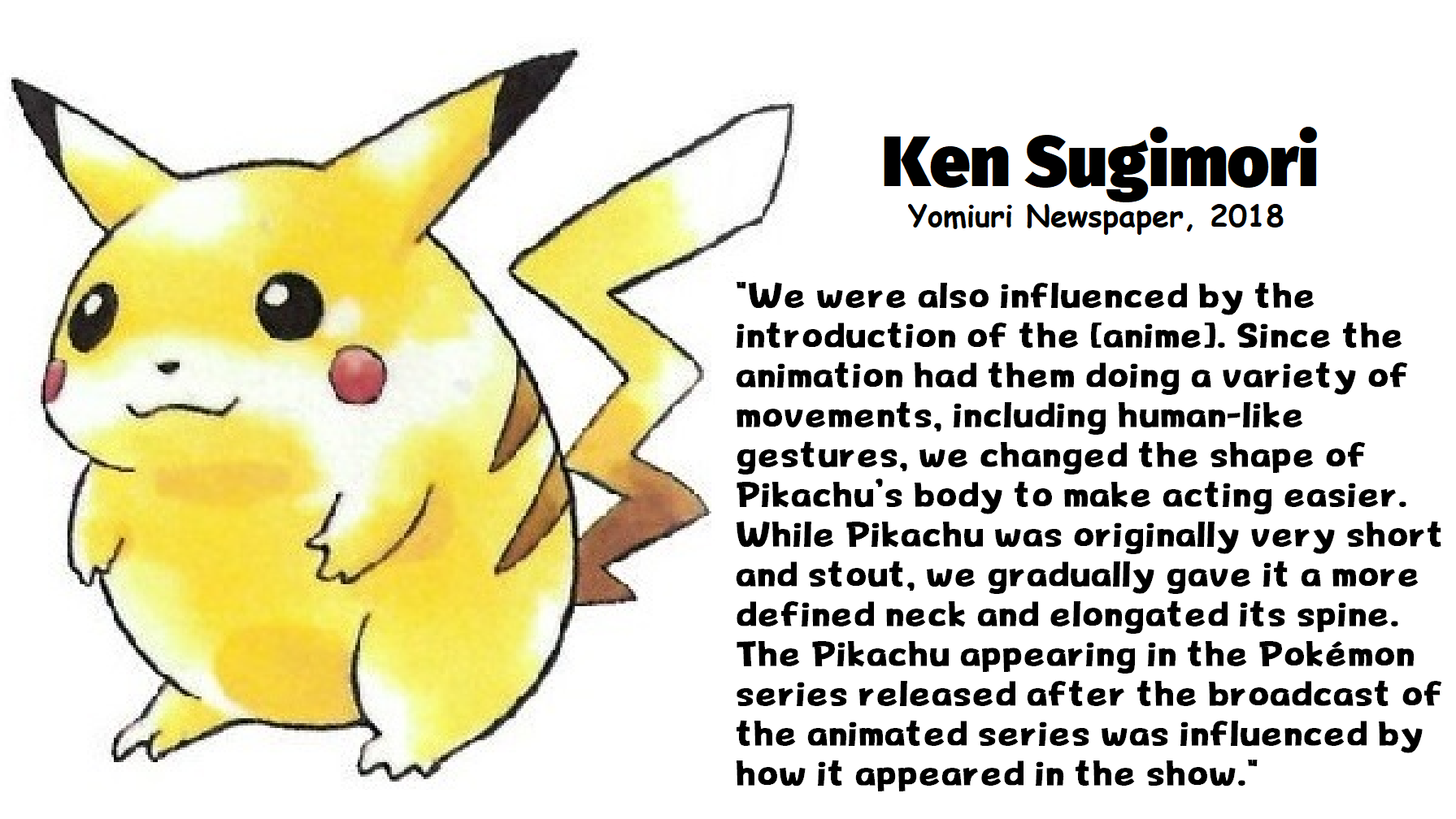
Dr Lava’s notes: Sugimori’s referred to this in the past — that Pokemon’s anime appearances ended up influencing how they looked in the games. Fat Pikachu’s probably the most famous example. He was slimmed down so he’d be easier to animated in the TV show, then his thinner design was later carried over into the games and Sugimori’s future artwork.
Haunter’s another prime example, having lost two fingers during the Pokemon anime’s first season. The evolution of Gen 1 designs in the 90’s is really quite complex. First there were black and white sprites, then color was added for the Super Game Boy, then Sugimori revised many of the designs when he made each Pokemon’s artwork, which of course used the colorized sprites as a base. Then lots of designs were altered yet again by the folks animating the Pokemon TV show, so Sugimori and his team followed suit for the sake of consistency. And of course, lots of Pokemon designs went through numerous revisions even before their Red & Green sprites were finalized, and some Gen 1 Pokemon even continued to receive revisions long after the 90’s were over.
“Do you still design the Pokemon sprites first and their artwork later?”
Sugimori: “Now we make artwork first, then the artwork’s used as blueprints for the 3D designers.”
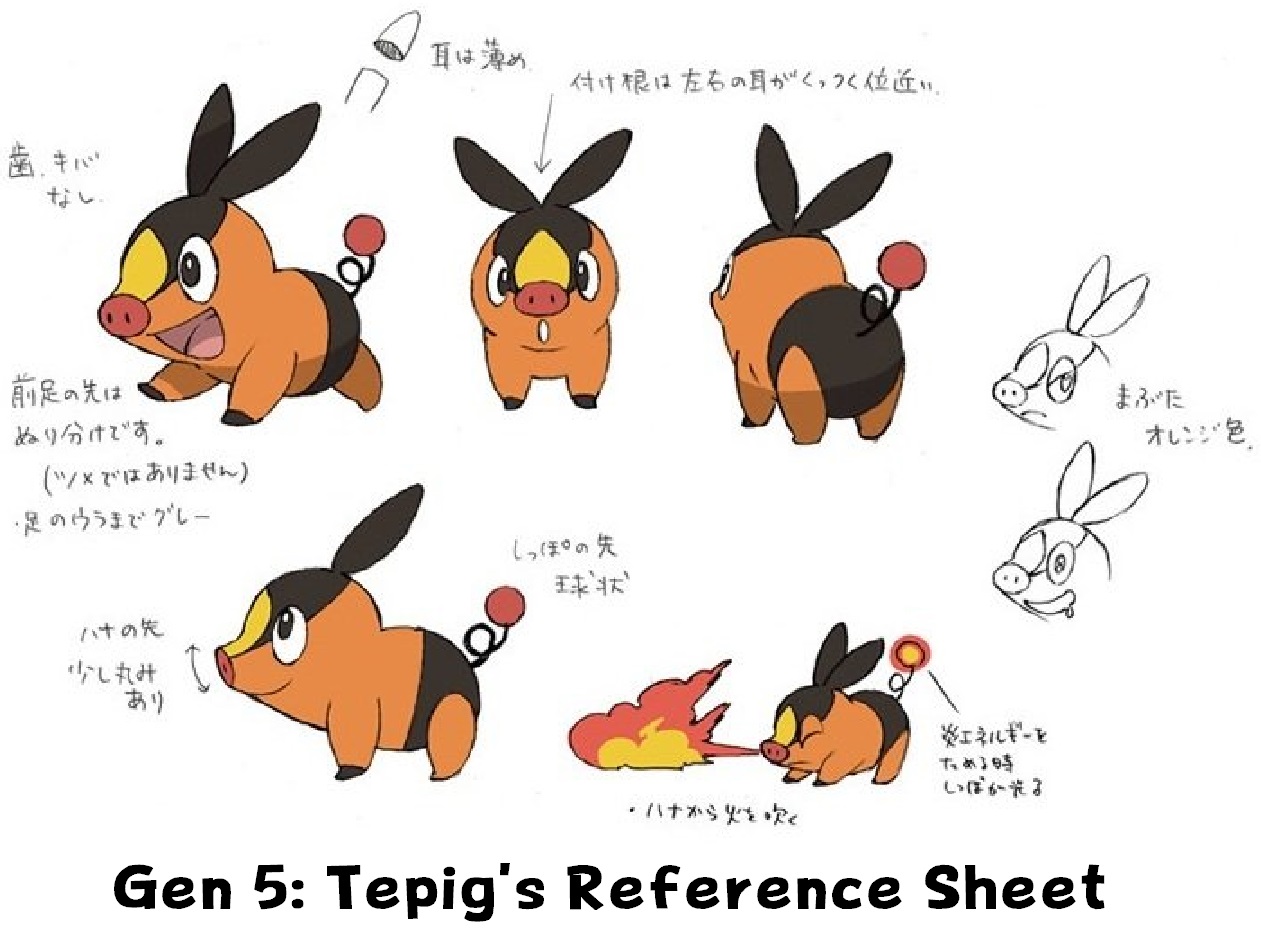
“Indeed, you’re not using sprites anymore, you’re using 3D models. As the games moved into 3D, were there aspects of the Pokemon design process that changed?”
Sugimori: “Absolutely. But of course we’re able to express a lot with 3D. For example, being able to put motion into Sylveon’s ribbons. They flow and it adds a lot of cuteness. It makes a big difference in designing.”
“Was changing the design order from in-game art into illustrations, to illustrations into in-game art something that just happened with the recent 3D games?”
Sugimori: “We started doing the illustrations around the time of Ruby & Sapphire. Before then, whenever we were asked about, say, how a Pokemon’s back looks for the anime or a toy, we didn’t have any reference except the sprites, so it was difficult to answer. So we started drawing those kinds of details more.”
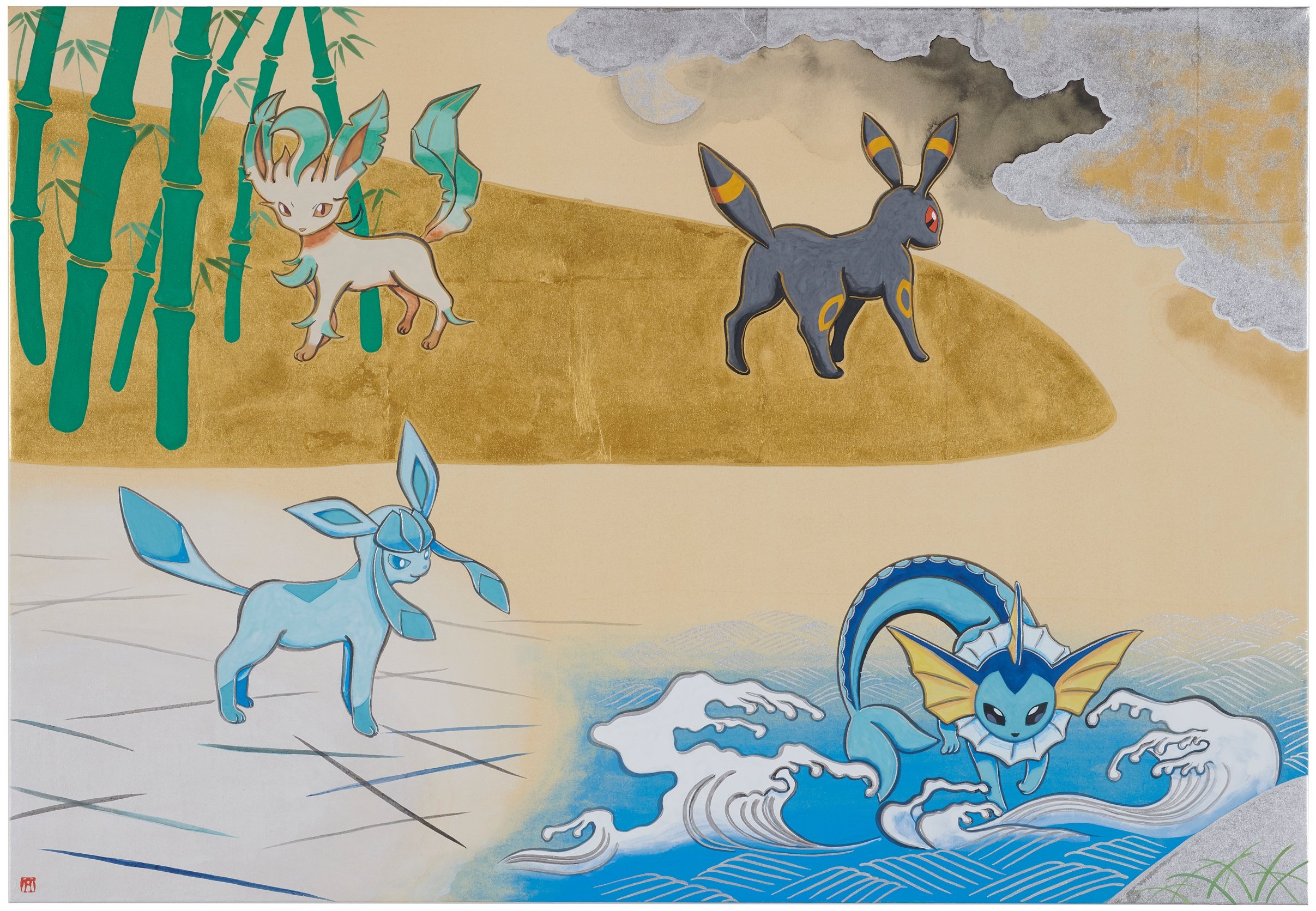
“So just what you’d made for the games wasn’t enough?”
Sugimori: “Right. Then starting with X & Y, 3D models became the norm.”
“You mentioned this before, but the process was basically creating artwork based on the sprites, then handing that artwork over to the 3D modelers to use as blueprints?”
Sugimori: “Back when we were using sprites, we were only creating the front and back views of Pokemon in 2D. When we were developing X & Y, we shifted to 3D and really started filling in the details. That was a 20 year process, so of course the original Eevee has quite a different vibe to it compared to Sylveon.” (laughs)
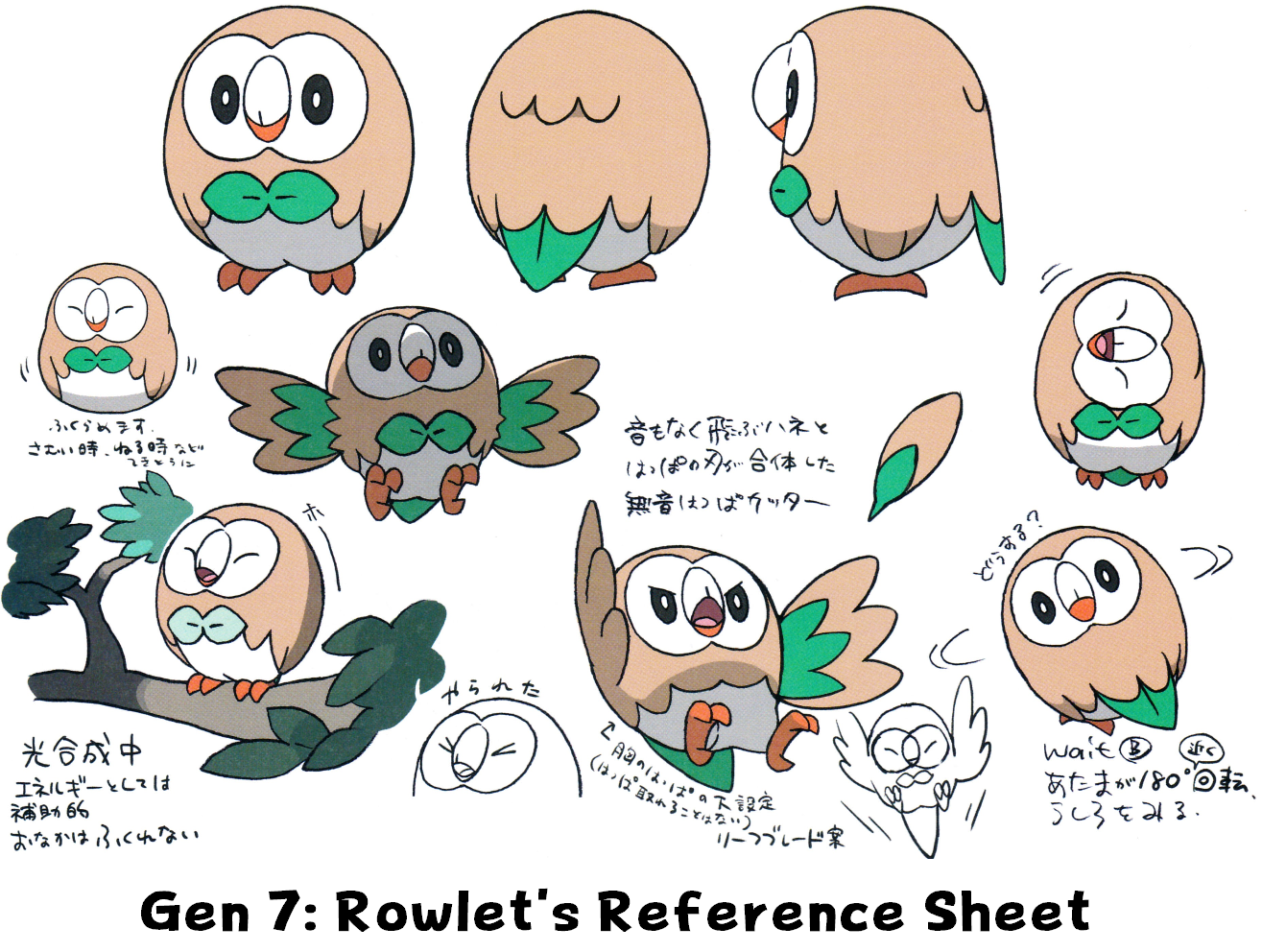
Dr Lava’s notes: In later generations, every designer made reference sheets for the Pokemon they created. As you can see from Tepig and Rowlet’s reference sheets, the amount of detail on display increased with each passing generation. The more detail, the less room for mistakes — this way the 3D artists, anime animators, and other illustrators know exactly what Pokemon looks like from every angle. But Game Freak wasn’t nearly as organized in the early generations. All they had was each Pokemon’s front and back sprites, along with Sugimori’s artwork, which always left some angles unseen.

As a result, 90’s Pokemon designs were pretty inconsistent, particularly their backsides. For example, some early sprites and artwork showed Charmander with spikes on his back, but the spikes disappeared in later depictions. In her Blue-era artwork, Female Nidoran had an extra back spike and what appears to be a tail — neither of which was ever seen again in any other sprites or artwork.
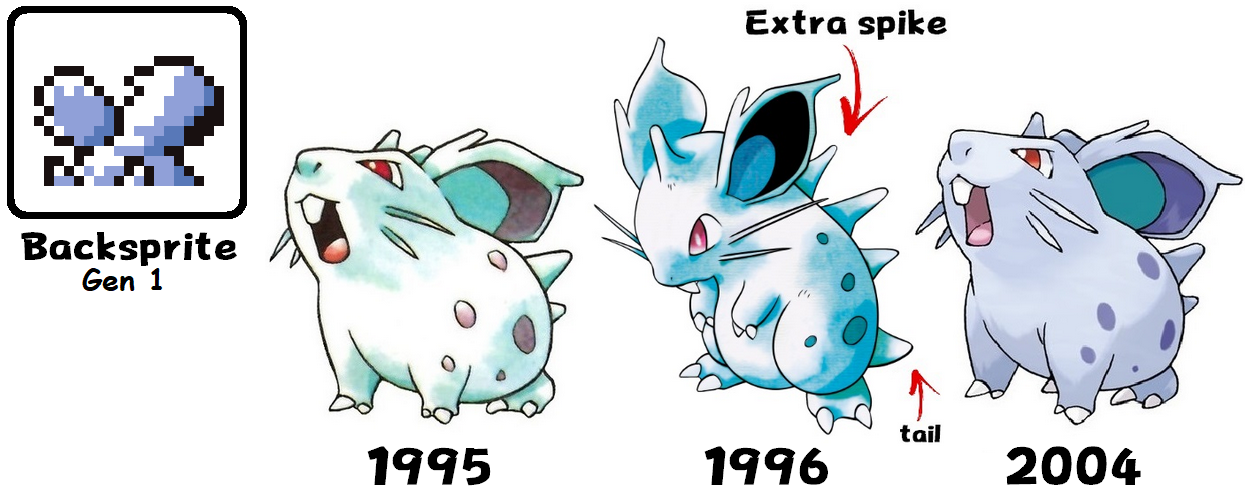
“Plus the way you design Pokemon in general has changed as well.”
Sugimori: “Which is why, even though the Eeveelutions are all part of the same family, it’s a fact that they’ve been influenced by the times and changed accordingly. What makes things easy is that since it’s still an Eeveelution, they all retain that same kind of plain design and charm.”

“Regarding those changes and also the things that didn’t change, Ms Nishida, do you feel like there’s an Eeveelution that really went in a new direction?”
Nishida: “Of course each Pokemon is influenced by the region and configuration of the game they’re created for, but as far as innovation, I’d say Sylveon. We really wanted to emphasize its Fairy theme.”
“Sylveon definitely has a unique look. Before deciding on its final design, were there some different designs you considered for Sylveon?”
Sugimori: “There were several. For example, one of the designs didn’t have ribbons and all that.”
Nishida: “Oh yeah, that’s right.”
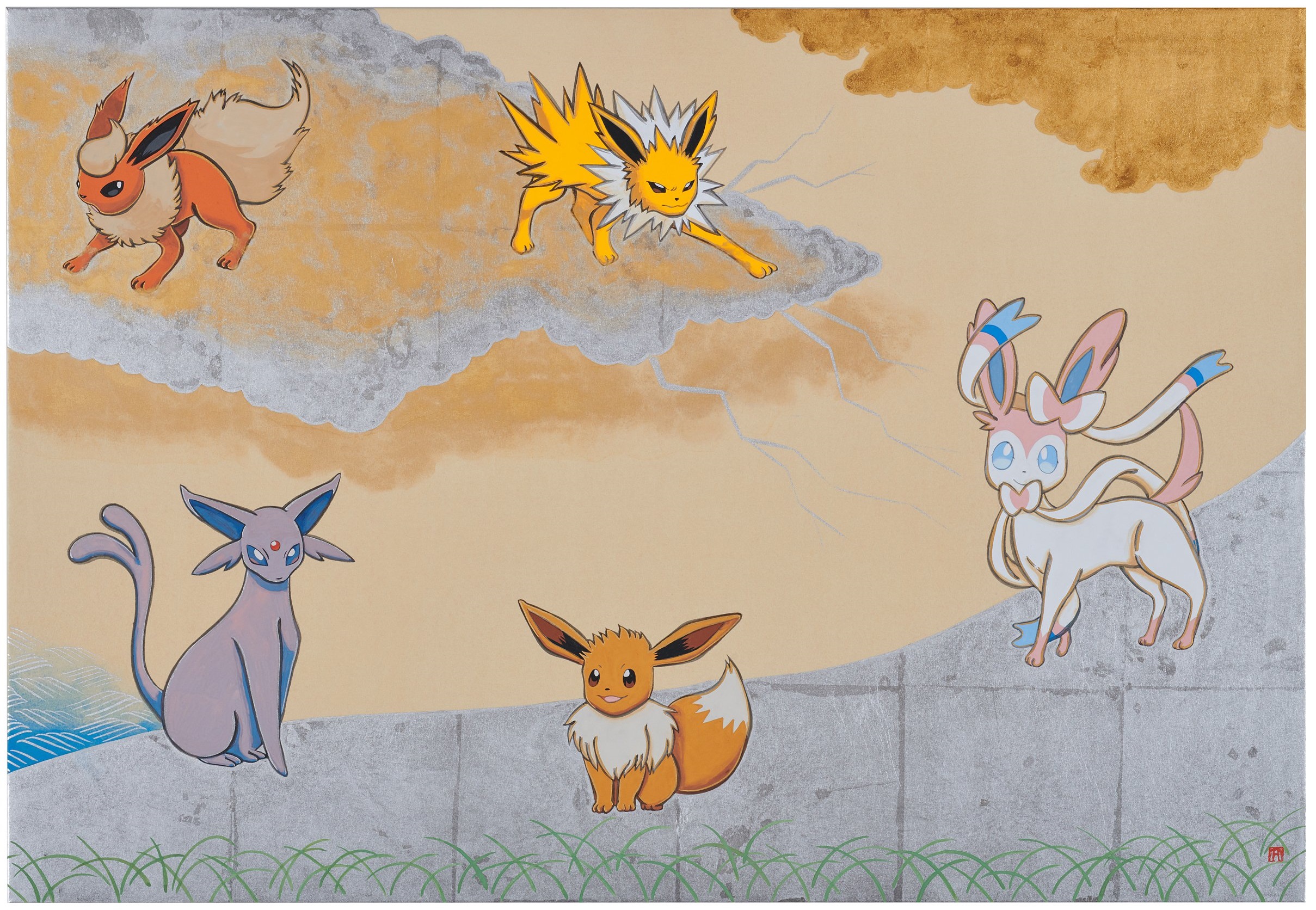
“As far as its figure, were they all kind of girly like the Sylveon we have now?”
Nishida: “Yeah, they were all that same style since it’s a Fairy-type.”
“Speaking of being feminine, Espeon also has that same kind of vibe. It’s very slim and even has hips, which was quite unique for its time.”
Nishida: “Ahh, you have a point. I guess in trying to make it look mysterious, it ended up looking feminine.”
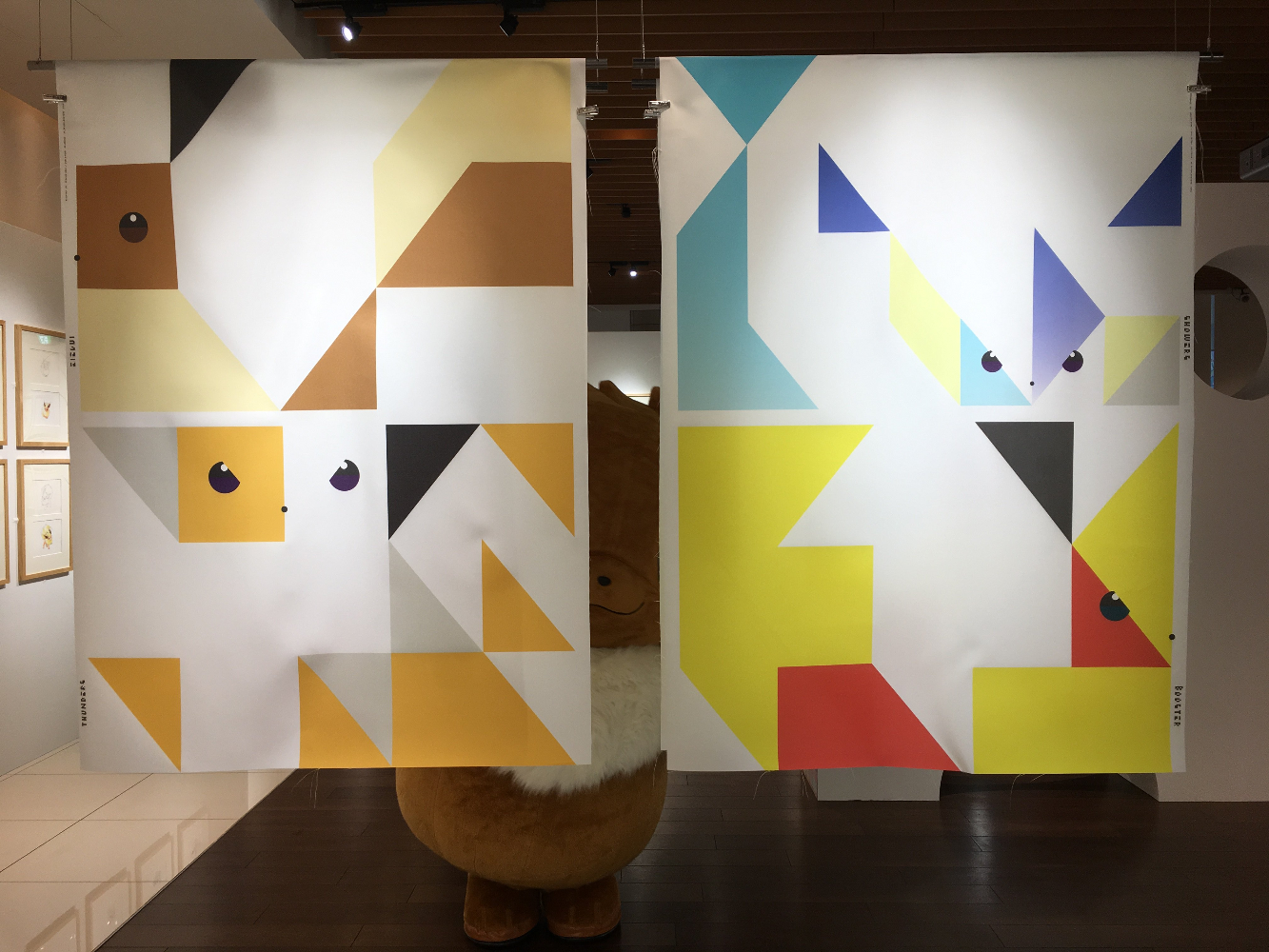
Variety Because There’s Two Designers
“Eevee’s Pokedex entries are quite unique. Stating things such as “its genetic code is unstable” and “there are only a few alive.” It’s very cute, but its existence is fragile. I feel like that adds a lot to this Pokemon’s appeal.”
Sugimori: “That’s right. And lots of Pokedex entries add sort of a harsh reality to Pokemon. ‘It gets eaten’ and stuff like that.” (laughs)

“And like how Cubone ‘wears the skull of its deceased mother.’ I see how these contribute to the lore and world of Pokemon, but are Pokemon usually created with these descriptions in mind? Or are the descriptions created afterwards?”
Nishida: “I think for Vaporeon, the design was created first. At that point in development there were a lot of Pokemon without descriptions that we eventually made some descriptions for later, it was kind of all over the place.” (laughs)
Sugimori: “I think for the Eeveelutions, the types were decided first, then the Pokedex entries were written later.”
Dr Lava’s notes: As with most aspects of development, things were pretty disorganized at Game Freak in the early generations. But in more recent years, there’s been a great division of roles at the company. Pokemon designer James Turner said in a tweet that nowadays, most Pokemon’s names and backstories aren’t created by the designers themselves, but by a dedicated lore specialist later in development. In a separate Twitter thread, James also said designers don’t have much say about their Pokemon’s stats or movesets — those are determined by Game Freak’s battle team.
Over the past few years, James has shared lots of interesting information about the development of Pokemon’s later generations via his Twitter account, so in December 2019 I searched through every tweet he ever made, recording the most interesting factoids. But the day after I started sharing these quotes on my own Twitter account, James deleted every tweet I’d recorded, a total of 96 tweets made between 2017 and 2019. After that, he stopped tweeting about Game Freak’s development process. Sad. For more info on James Turner’s deleted tweets, click here.
“For Pokemon created by people like Ms Nishida and Mr Fujiwara, do the designers often submit Pokedex entries they would like to be used for their Pokemon?”
Sugimori: “Yes, we get so many ideas from designers, and we use as much as we can in the creation process. For example, Sylveon has ribbons as part of its design, so we mentioned the ribbons in its Pokedex entries. Basically, we try to take interesting aspects of the designs and include them in the Pokedex.”
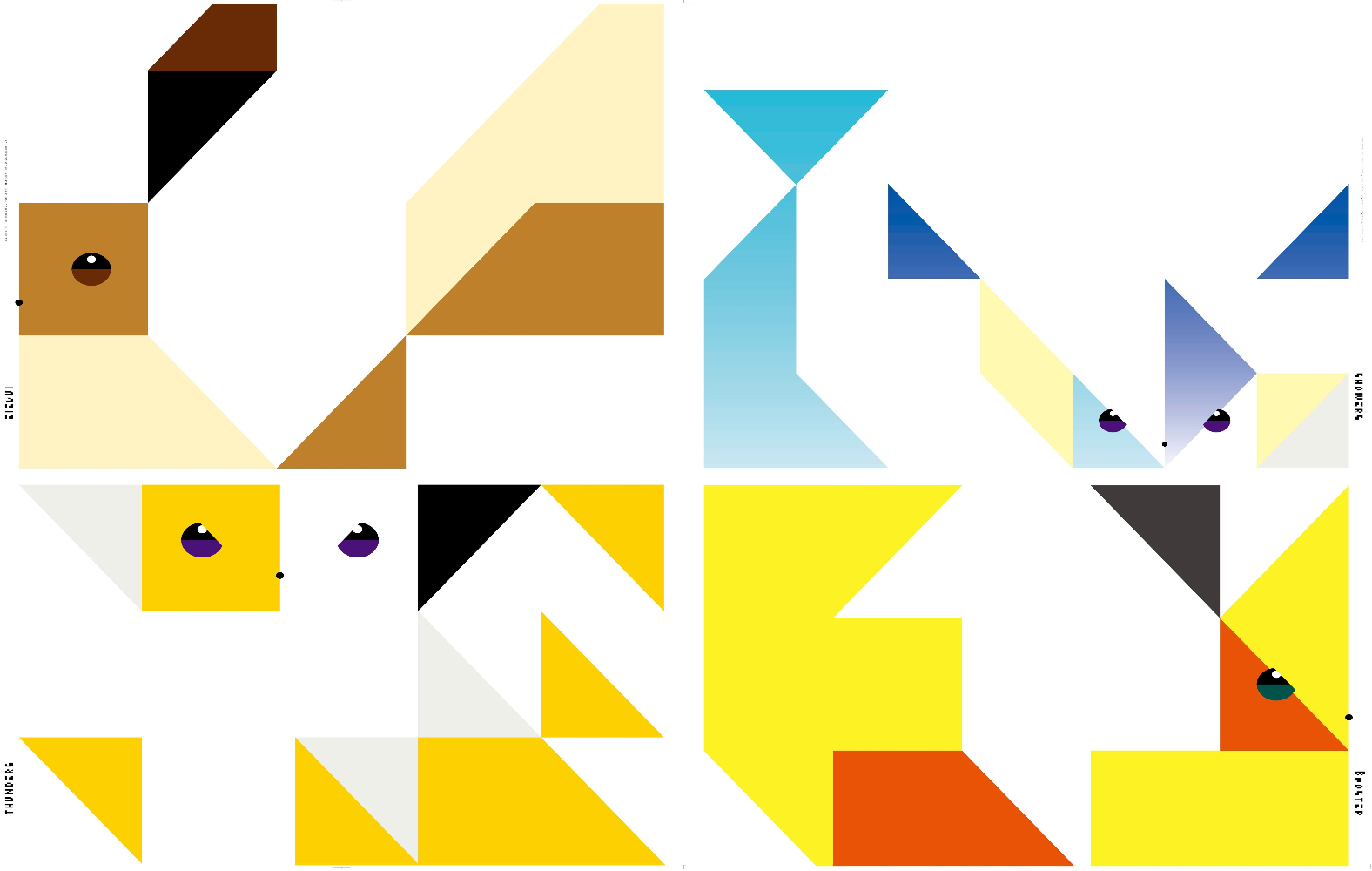
“That’s very interesting. Mr Fujiwara, when you saw the designs Ms Nishida made for Vaporeon, Espeon, and Umbreon, did you think ‘Wow, that’s not what I was expecting!’?”
Fujiwara: “I was very impressed with all of them. They were designs that I wouldn’t have come up with. I think that because the Eevee family was created by two designers, we got some great variation.”
Sugimori: “Ms Nishida makes gorgeous and flashy designs, while Mr Fujiwara tends to make more simple and charming designs. It makes for great Pokemon that aren’t too over-the-top. They can skillfully create designs that are well-balanced, and also look related and realistic.”
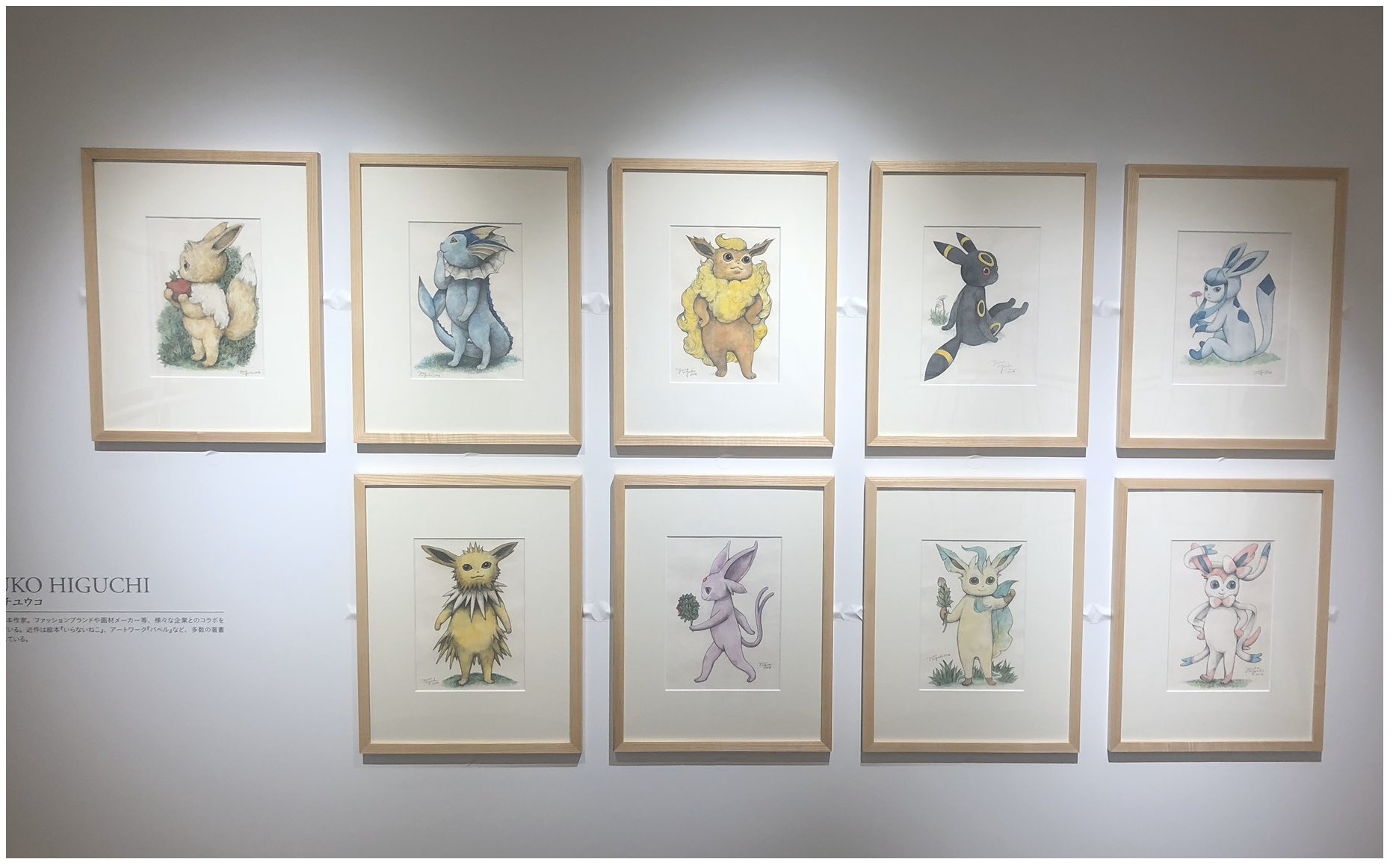
“Vaporeon’s dignified look and Eevee’s simplicity really bring out the best in each other!”
Sugimori: “I guess you could say everything worked out!”
“Eevee has a very unique relationship with the evolution mechanic. I suppose we’ll be seeing some more forms of Eevee sometime in the future?…..”
Sugimori: “You want to see a Bug-type or something?”
(everyone laughs)
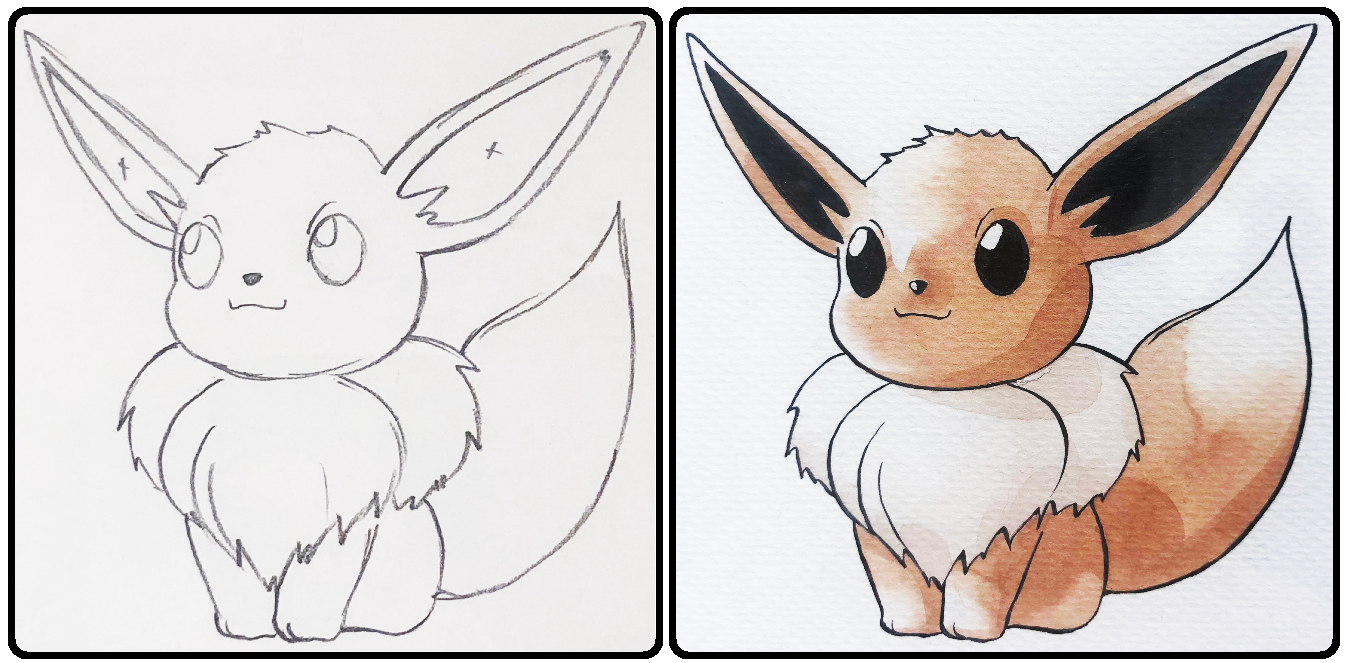
Eevee’s Name
“It’s been 23 years since Pokemon first launched, when you guys — as Eevee’s designers — take a moment to look back, how do you feel?”
Fujiwara: “At the outset, I never imagined things would go this far. When I drew Eevee for the first time, I wanted to create an animal that existed in people’s memories.”
“People’s memories?”
Fujiwara: “For example, when you went to your grandpa’s house in the countryside, maybe there was something like an Eevee there.” (laughs)
“Ahhh okay!” (laughs)
Sugimori: “Like a fluffy cat or dog.”
Fujiwara: “Like, ‘that time when I got lost in the forest as a kid, wasn’t that an Eevee I saw?!’ Even though it doesn’t really exist, somehow Eevee’s a creature that could exist in someone’s memory. When I listen to people tell me their stories nowadays, I know Eevee’s left an impression on their hearts, which is what I hoped for when I designed it.”

“Indeed, Eevee has its place in people’s memories. Eevee has a variety of evolutions, but I wonder if there are a lot of fans who grow an attachment to a particular Eeveelution because they already liked Eevee.”
Nishida: “That could very well be the case. When we design Eeveelutions, since its basic form is Eevee, we make sure to leave traces of the eyes or ears, something like that. All the Eeveelutions came into existence thanks to Eevee. I always keep in mind that it’s an evolution of Eevee, and I want it to be loved and remembered along with all the others.”
Sugimori: “I think it’s because when you look at all the Eeveelutions together, you can see how much variation they have. The fact that Eevee’s pretty featureless really plays to its advantage. It makes Eevee stand out as a character and makes it very easy to love.”
“There is a very strong affinity for Eevee no matter where you go in the world. Maybe it’s a fox, or a dog, or a cat. Maybe Eevee isn’t actually anything in specific, but somehow that’s what makes people around the world feel special about it.”
Sugimori: “More than it being explosively popular, Eevee’s just always been loved. As a stand-alone Pokemon, Eevee’s a previous gem that has the potential to shine even brighter than it does now, but we make an effort to preserve Eevee’s simplicity, since that’s what fans love about it.
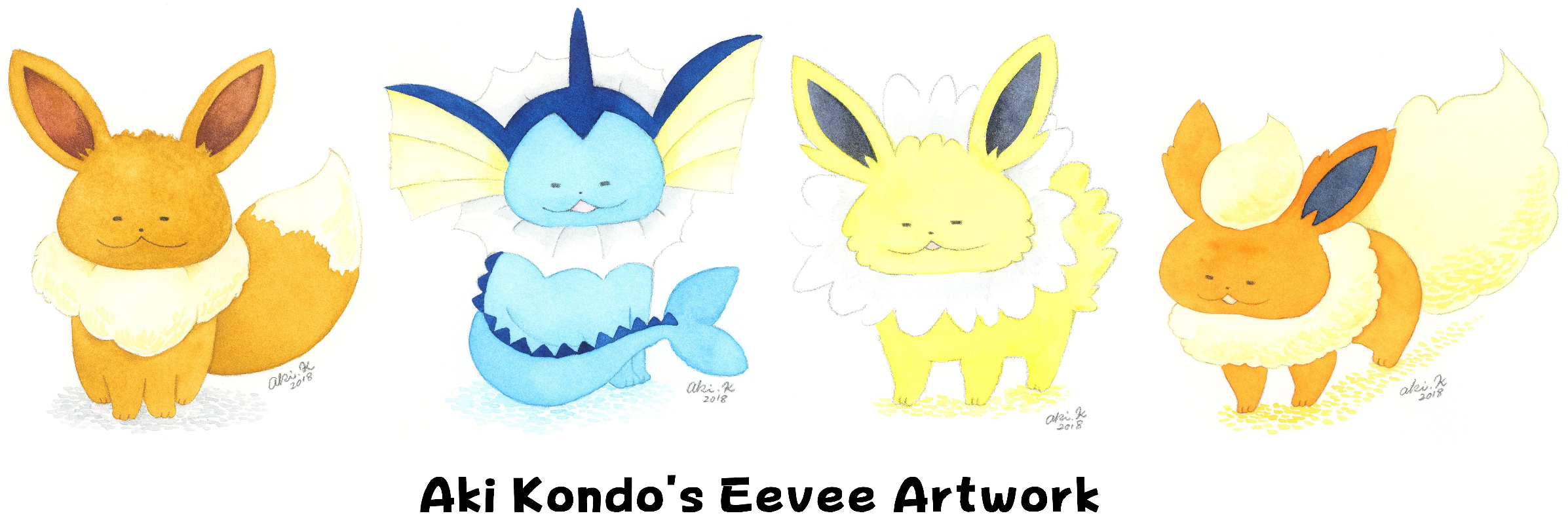
“Aki Kondo, a participant in this Eevee exhibition, has stated that ‘I feel a little lonely after Eevee evolves.’ Of course, Eevee has such a good-natured and nostalgic presence. You just want to keep it by your side!”
Nishida: “That’s right. And you can feel at peace.” (hugs an Eevee plushie)
“I could see how someone would really love to have an Eevee around.”

Sugimori: “Despite that, Eevee’s one unique feature is its evolution. It’s even in the name!”
“In the name?”
Sugimori: “It’s the first two letters of evolution, E and V.”
“I see! So it’s the Pokemon that embodies evolution?”
Sugimori: “Correct. Eevee’s feature is evolution.”
“It has no other feature except its evolution. Wow!”
Sugimori: “That’s Eevee’s one and only feature.”
Nishida: “Even though it’s so cute, it carries all this responsibility on its back.” (laughs)
(Everyone laughs)
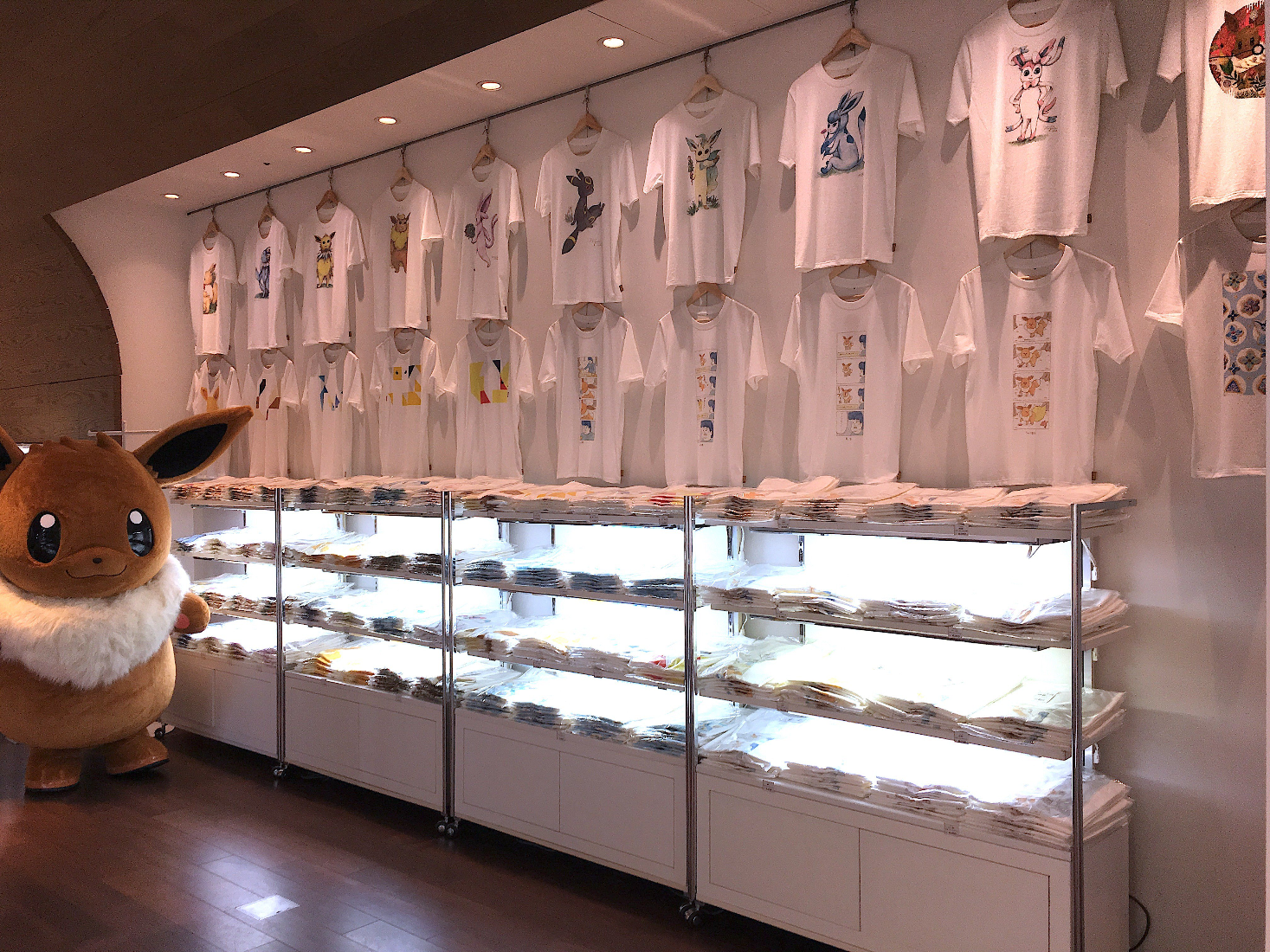
Closing Comments
Dr Lava’s notes: You probably never got a chance to attend the EVs+cafe exhibition, browse the merch, or buy the book. But hopefully after reading this interview, viewing the artwork, and seeing photos from the event, you feel like you got to experience the next-best thing. And along the way, got to learn a lot about how Pokemon were created throughout the generations — not just the Eevee family, but all the series’ monsters.
Thanks again to Anthony Madry for cutting me a fair rate on this translation, and for triple-checking and rephrasing lots of key quotes. If you’d like to read more Pokemon translations just like this one, there are some links down below, or you can check out this website’s homepage. If you’re interested in helping the site publish more translations, please consider signing up to support my work for a few bucks a month on Patreon. It really makes a huge difference, and there’s a few translation articles that are only available on the Patreon page. If you’d like to contact me about this translation, or for any reason at all, I’m most easily reached on Twitter, where I’m @DrLavaYT. Okay I hope you enjoyed this coverage of the EVs+cafe exhibition, thanks for reading.
Read More Pokemon History:
• Translation: Sugimori Explains Gen 5 Pokemon Design Origins
• Translation: 90’s Pokemon Anime Was Written Under the Influence
• Leak: Controversy Surrounding Gen 1 Beta Sprite Leak
Videos About Pokemon History:
• Translation: Sugimori Explains Gen 5 Beta Pokemon
• Cut Content: Gen 4 and 5’s Scrapped Lock Capsule Event
• Cut Content: Gen 4’s Internal Data and Cut Content
